#digimon adventure episode 54
Explore tagged Tumblr posts
Text
literally agonized by the imagery of the sun coming up in the real world as the fight in the digital world ends. they had tomorrow waiting for them. they couldn't die here. and so they didn't, the sun rose, and a new tomorrow began. and all the parents are watching, waiting, unaware of truly how much time had passed for their kids, truly unaware of the agony, but knowing in full what their kids had just done. heroes in the form of little kids disappearing from the sky and the sun rising for a new dawn. ack
#digimon adventure episode 54#a new world baby.............#aegughu.#digimon#matts digimon originals#digimon spoilers#tag for my buddy kark
5 notes
·
View notes
Text
Digimon Adventure 02x06 - A Perilous Picnic / Family Picnic
Previously on Digimon Adventure: Iori's grandpa accidentally offered to make out with him and it was so awkward that Iori fled to the Digital World. There, Jou gave him a pep talk about self-determination, and Iori gave him his name in return. Then they had boiled crayfish for dinner.
We've almost gone on a life-changing vacation with every single member of the original Chosen Children. There's just one left. And we've saved the best for last.

Right from the start, a plane touches down at a Tokyo airport, and a crowd of people disembarks. GUESS WHO'S BACK, BITCHES!!!
Mimi: It's been so long since I've been in Japan....
She takes out her Digivice, fixing the time over from Eastern Standard Time to Tokyo. Not sure why her departure from the U.S. is labeled with its time zone but her destination time isn't Japan Standard Time.
Then again, J.S.T. is sometimes called Tokyo Standard Time so that might be the case here. I'm not 100% on the cultural particulars for what people preferred to call the time zone in 2002.
In any case, her time changes from 6:54 PM to 8:54 AM, which means she is going to have insane jet-lag.
Mimi: It's still morning. Alright!
Mimi tries weakly to give herself a shot of energy, takes three steps, and then lets out a huge, unstoppable yawn.
Mimi: So sleepy....
...Mimi must have a super early bedtime, because 7 PM isn't that late.
(They had to nerf Mimi or else she would be unstoppable. Dragging the Digimon Kaiser out of his control room by his ear and ripping into him in two parallel dimensions about his cruel mistreatment of the Digimon and also his hideous edgelord fashion. Who wears a wig to make their hair look unkempt!?)
In the dub, while the plane is setting down, they add in a flight attendant's voice over the P.A. system.
Attendant: Attention, passengers. East Means West Airlines welcomes you to Tokyo. Again, we apologize for the pilot stepping out for popcorn during the in-flight movie. (Everyone disembarks into the airport) Intercom: Would the owner of the gray 747 parked outside the window please report to the cockpit? Your lights are on.
Haha. HahahahahahahahahaHAHAHAHAHAHAHAHAHAHA
That was good. Brilliant gag to open the episode on. Not just the direct jokes about the plane's bumbling pilot, though those are good. But also "East Means West" as the name of an airline that flies West from the U.S. to reach the "Far East" Asia. I love it.
Mimi: It's so bright out and I'm wide awake. What time is it? ...8:54 in the morning!? I'm still on New York time! (Mimi fishes out her Digivice) Mimi: I'd better change my watch. (Mimi changes the time) Mimi: There. Now I'm caught up. (Mimi tries to leave and gets caught up in a huge yawn) Mimi: I'm exhausted....
Mimi calls it a watch but it's clearly her Digivice. Though it's possible that she's gotten into the habit of referring to it that way during her time in New York, since it has limited utility outside the Digital World.
In the original, Mimi clearly states that this she hasn't been in Japan for a long time. Dub Mimi leaves it to the imagination.
Meanwhile, at the Motomiya residence, Daisuke oversleeps his alarm.

The alarm, which continues ringing incessantly throughout the scene wakes Chibimon. Realizing Daisuke isn't getting up, Chibimon calls out to him.
Chibimon: Daisuke...? ...huh?
Amid the gross disaster zone that is Daisuke's room, Chibimon finds him passed out in a pile of school supplies and snacks.
Chibimon: Daisuke! Daisuke! DAISUKE!!! DAISUKE!!!
When Chibimon's loudest shouting fails to wake Daisuke, he moves to plan B. He jumps on Daisuke's stomach and bounds up and down on top of him.
Chibimon: (bounce) DAISUKE!!! Daisuke: Urk...
It takes four bounces, but Daisuke's involuntary resolve to remain asleep finally breaks. He opens his eyes to see Chibimon sitting on his gut.
Chibimon: (pleasantly) Good morning, Daisuke. Daisuke: ...uh... good morning, Chibimon. ...why does my stomach hurt...?
Probably something you ate, I'm sure. No need to interrogate it too closely.
It seems the Chosen Children were able to smuggle their Partner Digimon home with them this time, rather than leaving them in Computer Club.
The dub, as usual, misses the show's audio cues. The blaring morning alarm that Daisuke's sleeping through is not present at all in their version, which strips DemiVeemon of his reasonable urgency in waking Davis.
DemiVeemon: Davis? Wake up! Davis: (loud snoring) DemiVeemon: Davis! Davis! DAVIS!!! DAVIS!!! (DemiVeemon jumps on Davis) DemiVeemon: DAVIS!!! DAVIS!!!
Davis does not react audibly to DemiVeemon's hops. Though we hear the sound of flesh smacking to indicate DemiVeemon's four impacts, there are no reactive grunts from the sleeping Davis.
Davis: (waking up) ...huh? DemiVeemon: (pleasantly) Good morning! Sleep well? Davis: Yeah, until I heard all that screaming. The next time I tell you to wake me up, try to be a little quieter so I can get some sleep.
Oddly, Davis objects to the shouts that failed to wake him up instead of the jumping on his gut. In lieu of the ringing alarm, his last line is meant to explain why DemiVeemon spent this scene so frantically trying to rouse him.
This scene is one case where dubbing purely off a translated script and making up the audio as you go really hurts the scene. The script for the scene is solid, but the missing sounds of the alarm and Daisuke's reactions to Chibimon's hops leave it a pale imitation of the original.
Over at his place, Iori gets dressed while wondering about Upamon, who's gone missing.

Iori: Where could Upamon have gotten off to?
Opening his bedroom door, he quietly calls into the dining room.
Iori: Upamon?
Sure enough, that troublesome Digimon is sitting on the dining room table, wearing a basket on his head as a Solid Snake disguise. When he sees that Iori's awake, he jumps down from the table and hops over to him.
Upamon: Iori! Iori: (scolding) You can't just go wandering around the house like that. Upamon: Your mom is making something weird! Iori: Something weird?
Fumiko, Iori's mother, is in the kitchen slicing sushi rolls. Iori takes Upamon back into his room.
Iori: That's kanpyoumaki. Upamon: Kanpyoumaki? Iori: Yes. Miyako-san requested it. Kan-pyou-maki.
Kanpyoumaki is a gourd-based vegetarian sushi roll. In place of the typical fish, it uses rehydrated strips of the calabash gourd, which are called kanpyou. The kanpyou are soaked for upwards of 24 hours ahead of time to soften them back up. Then they're boiled, sauced, and sliced into your typical sushi roll with rice and nori, a type of seaweed.
In the original, it's not clear how long Upamon's been spying on Fumiko from beneath his terrible basket disguise. Cody in the dub states in no uncertain terms that he hasn't been doing this for very long.
Cody: I turn my back on him for one minute and he disappears! Upamon, where are you? (Cody opens the door to peer into the dining room) Cody: Hmm? Upamon! Upamon: Hmm? Cody! (Upamon bounds down and hops over to Cody) Cody: How many times do I have to tell you not to wander around the house!? Mom might think you're a rodent! Upamon: Guess what! I think your mom is making us some candy over there. Cody: Candy? (Closeup shot of Fumiko cutting sushi before Cody takes Upamon back into his room) Cody: It's not candy, it's sushi! Upamon: Does it taste like candy? Cody: Not really. It's seaweed and raw fish. Upamon: Yucky! Cody: Hehe, that was my first reaction too.
Seaweed and boiled gourd but it's fine. I don't expect American nine-year-olds to be super familiar with the various types of sushi.
It was very common for dubs of this era to try and pass off clearly Japanese food items as localized American products. We all know Brock from Pokemon and his rice ball-style double bacon cheeseburgers and jelly donuts. So there's something really funny to me about Cody and Upamon having an "It's candy!" "No, that's sushi," exchange in the show itself.
That Cody nonetheless still manages to misrepresent the sushi is the icing on the cake.
Also, apparently Upamon Solid Snaking it around the house has been a persistent problem in the dub. I love the implication that he got in trouble for this before and went, "Got it. Next time: Basket hat. No one will ever know." Like this wasn't just a shitty plan; This is what he worked his way up to.
I am a firm believer that "again" is the funniest word in the English language.
Over at her place, Hikari's packing her backpack.

She breaks the fourth wall by humming "Break Up!", the show's kickass evolution and fuck these guys up theme. The replacement for "Show Me Your Brave Heart". It's an earworm, to be sure.
Hikari: (humming) Tailmon: (reluctant) Am I going in there too? Hikari: That's right, Tailmon.
With a huge shit-eating grin on her face, Hikari picks a distressed Tailmon and stuffs her into the backpack, despite Tailmon's wriggling and muffled groans of protest.
Hikari: Come on, get in! Get in!
At his place, Takeru steps out the front door, calling out the traditional Japanese farewell.
Takeru: Ittekimasu!
Before he can step out the gate, he suddenly realizes he's missing something. He goes back inside.
Takeru: Ah! Forgot something!
Takeru emerges with a furiously wriggling backpack.
Patamon: TAKERU!!! HOW COULD YOU FORGET ME!?!? Takeru: (sheepish) Sorry, Patamon....
Rude! And after all they've been through together. XD
In the dub:
Kari: I've made a nice little bed for you, Gatomon. Gatomon: You think I'm getting in there!? Think again! Kari: Oh come on. Be a sport, ahahahaha! (Kari picks up Gatomon and stuffs her in) Kari: It'll be fun!
Sad to lose Kari's fourth-wall breaking but they do nail Gatomon's muffled protest noises so this is pretty solid.
T.K.: I'm leaving now! I'll be back later! (T.K. almost leaves, then stops) T.K.: Oops, one more thing. Patamon! (T.K. goes back in and retrieves his angry backpack) Patamon: Will you hurry up!? Your gym socks from yesterday are in here! T.K.: (sheepish) Sorry, I forgot.
Not sure why they needed to change the punchline. It was pretty good as is.
...why is T.K. even bringing old gym socks to this event? That's gross, T.K. That's Davis-level gross.
If this were Cody, Davis, or Yolei, I might ding them for bluntly saying they forgot their Digimon when they enter the apartment. But Kari and T.K.'s parents already know Gatomon and Patamon. They were in Odaiba that day.
At her family's convenience store, Miyako loots the shelves and fills up a duffel bag while her mom notes down all the inventory she's making off with.

Miyako: Three with tuna mayo, two with bonito flakes, and one orange drink.
That's right, tuna mayo. The combination of tuna and mayo is so universally recognizable as the correct way to consume tuna that "tuna mayo" is a recognized ingredient in Japan.
Both tuna mayo and bonito flakes can used to make rice balls, which is what she's picking out. We don't get to see it for ourselves, but she clarifies it later in the episode.
The orange drink is probably a literal orange drink, not a rice ball topping. Though the way she counted them off did give me mental images of soaking a rice ball in Crush or Sunkist. Daisuke would eat it. So would Mimi.
Miyako: This is all for the Computer Club's picnic. Mother: (jotting down) Three with tuna mayo, two with bonito flakes, one orange drink. Where are you going for this picnic? Miyako: Add two anpan.
Anpan are sweet rolls filled with bean paste.
Miyako: (annoyed) And we haven't decided yet! Mother: That's suspicious. Miyako: (irritated) It's not suspicious at all! Mother: ... Miyako: BYE MOM!!! Mother: MIYAKO!!!
Miyako unsuspiciously bolts out the door with her bag full of appropriated merchandise before her mom can interrogate her any further.
She makes it out the door, but then her duffel bag yelps in pain.
Poromon: GYECK!!! MIYAKO-SAN!!!
Miyako stops, unzipping her duffel to check on Poromon who's been stuffed in there with all the picnic supplies.
Miyako: Oh no! Poromon, are you okay? Poromon: I'm okay, but don't shake me around so much! Miyako: Sorry, sor-- Takeru: (calling out) What's going on, Miyako-san?
Takeru and Iori are right there, watching Miyako sheepishly apologize to her dufflemon.
Iori: Let's get going! Miyako: (embarrassed) Ehe ehehe....
I don't think any of the Digimon like this particular method of passing Stealth checks.
In the dub:
Yolei: Okay, mom. I think I'm packed. Besides the usual, I'm also taking potato salad, macaroni salad, tuna salad, chicken salad, fruit salad, and three-bean salad. Mother: Actually, it's only two-bean salad today. I was out of the third bean. That's an awful lot of food for one girl to have for lunch. Yolei: I told you, I'm having a picnic with the Computer Club today. So I offered to bring salad for everyone. Mother: And who's paying for it? Yolei: Yeah, I need to talk to you about that... Mother: ... Yolei: TALK TO YOU LATER!!! Mother: YOLEI, WAIT!!! (Yolei flees the store with appropriated goods in hand) Poromon: (muffled) YOLEI, HURRY!!! OPEN UP!!! OPEN UP!!! THIS IS AN EMERGENCY!!! Yolei: What's the matter, Poromon? Poromon: Sitting on this coleslaw's getting a little messy! And what's in here that has such a foul smell!? Yolei: Deviled eggs! Poromon: PEE-YEW!!! T.K.: Poromon's right, I can smell them from all the way over here! Yolei: I guess the mayonnaise has gone bad.
Yolei's picnic goods are heavily localized. However, since we only directly see the merch when Miyako opens her bag, Yolei gets away with it pretty easily.
Per the last time Yolei brought treats from the family store, her dub family expects her to pay for everything she takes. This presents the scene with a complication. At no point does Miyako exchange money with her mother, nor is there any indication of an expectation that she will.
So the dub uses the existing joke of Miyako skirting away before her mom can make her explain herself, and makes that into a joke in which Yolei whole-ass robs the family store. XD
Incidentally, someone on the dub team really likes the "I only have two beans" joke. They made (or will make) that same joke with Tai's mother Yuuko in Digimon: The Movie.
The dub also changes out the bit with Poromon getting crushed by jostling merch during Miyako's Shoplifter Sprint, replacing it for an extended bit about rotten eggs.
Lot of dub-exclusive olfactory offenses being committed in the lead-up to this picnic.
Now that everyone's ready to go, Miyako, Iori, and Takeru meet up with Daisuke and Hikari who are already hanging out outside of Odaiba Elementary.

Miyako: Sorry to keep you waiting! Daisuke: Ah, there you are. Hikari: We're all here. Daisuke: Yes! Let's go have a PICNIC!!! Group: YEAH!!!
But we're gonna have to be sneaky about it 'cause we aren't allowed to be here. The team creeps over the hedges, making sure the coast is clear. Then they slide the gate open and sneak onto school grounds.
Once inside the school building, Miyako starts complaining about the injustice of their situation.
Miyako: (whispers angrily) Why do I need to sneak around to get into the Computer Clubroom when I'm already a member of Computer Club! Iori: (whispers) It can't be helped. The rules strictly forbid the use of school facilities during off-days. Daisuke: (hisses) BE QUIET!!! (Miyako and Iori bow sheepishly)
The precise reason for school closure isn't expressly stated. The word is 休日 kyuujitsu, which is a catch-all for any sort of involuntary day off. Holidays, weekends, snow days, what have you. If you can't go to school or work for reasons you didn't personally request yourself, it's 休日 kyuujitsu.
In the dub:
Davis: Aren't the others supposed to be here? Kari: Yeah, they're late. Davis: Here they come now! Hey, what took you guys so long? Yolei: I stopped at a drinking fountain to give Poromon a bath. It's a long story. Davis: Never mind! Let's go!
That payoff for the deviled egg and coleslaw bit is pretty funny. XD
The dub takes their first commercial break here, and then we return at the start of our sneaking mission - with some extra dialogue.
(DigiDestined peek over the hedge) Davis: All clear. (Davis opens the gate) Davis: Now everybody remember my plan: CROUCH!!! (The team sneaks inside) Davis: Keep crouching! (They make it up into the school) Yolei: Listen, I know it's a Saturday and we're not really supposed to be at school but nobody is within miles of this place! I refuse to crouch. Hmph! Cody: Actually, Davis, I don't think it's really necessary for me to crouch. Davis: I got us here! Am I the best or what!? (Yolei and Cody bow sheepishly)
That Miyako isn't bothering to walk around the halls in Sneaking Mode and Iori is so small that it isn't necessary is a funny bit of visual characterization. The dub works the dialogue around to emphasize that, while still conveying the key point: The school is closed and that's why we need to break in.
Though we lose Miyako's outrage at the perceived unfairness of the rules. Instead, she just thinks Davis is an idiot, which is not an unfair assessment of his behavior.
Additionally, Yolei's line doesn't really connect with the animation. She was visibly crouching when they were outside. Miyako only straightens up once they're safely inside the building, so the dub's gag needs for you to have not noticed that.
Since they threw out the part where Daisuke scolds Miyako and Iori for chitchatting during a Stealth Mission, the final shot of the pair bowing in embarrassment has to be recontextualized. In this version, it seems like it's supposed to be a mutual cringe at Davis's bragging.
Once Iori and Miyako have been scolded, the team keeps going until they reach Computer Club.

Daisuke: (whispers) Let's head in.
They slip inside, quiet as a mouse, and head over to the computer containing the Gate. Miyako loads it up, and we hear the activation chime signaling that the Gate is open.
Daisuke: Go ahead, Miyako. Miyako: Bingo! Chosen Children, LET'S ROLL-- (Door opens) Mimi: ...what are all of you doing here?
Three out of five Children freeze up in panic, as well as their Digimon. But the other two and two....
Hikari, Takeru & Digimon: Mimi-san!? Others: Huh!? Mimi-san!? Mimi: Takeru-kun? Hikari-chan? Takeru & Hikari: Yeah! Takeru: Daisuke-kun, Miyako-san, Iori-kun. This is Tachikawa Mimi-san, one of the older Chosen Children.
Tachikawa Mimi is a Chosen Child-type Human. Her "Specialty Skill" is listed as Otome no Nage Kiss, or "Maiden's Blown Kiss", and she also has the Special Attack Unchi Tsukami meaning "Poop Grab". Though the ン in ウンチ Unchi appears to be censored. This is a reference to that time she seized a Garbamon's Poop projectile and chucked it back at them.
Mimi originally debuted in the Digimon Adventure OVA before going on to feature as a main character in the anime that followed. She's had to move around a lot, first from Hikarigaoka to Odaiba and then to the United States. In video games and other supplemental media, she is typically accompanied by her Partner Digimon Palmon.
Narrator: Tachikawa Mimi! She lives on the East Coast of the United States. She's returned to Japan briefly in order to attend her cousin's wedding on behalf of her parents, who are busy with work. Miyako: Sora-san told me about you! Mimi: She didn't say anything weird, did she? Miyako: (sheepish) ...bingo.... Mimi: (irritated) Oh, did she? Daisuke: We're Chosen Children now. Mimi: Ehehe, I see that.
I don't know why Mimi gets a rundown from the Digimon Analyzer. XD But I'm here for it.
In the dub, a school bell inexplicably rings when the kids enter Computer Club despite school being closed.
Davis: Let's go! Hey, I wonder if the Digital World's open on Saturdays?
Once they're inside, Davis says nothing and the camera hangs awkwardly on the group in silence for three seconds instead.
Yolei: Alright! I got us in! Am I the best or what? (Door opens suddenly) Group: HUH!?!? Mimi: I'm sorry, but... Are you supposed to be here? Kari, T.K., & Digimon: Mimi! Others: Mimi!? Mimi: Um, T.K.? Kari? Kari: Yup! T.K.: Yup! Davis, Yolei, Cody, I want you to meet someone. This is our friend Mimi. She's one of the original DigiDestined who moved to America. Mimi: (rundown) I'm Mimi! I've set my sights on success in the fashion world of New York City. Don't think I'm just a strawberry blonde beauty who knows she's beautiful! Yolei: Hi, Mimi. Sora told us all about you! Mimi: I spoke to her! She told me about you too! Davis: (flirty) Hello, Mimi! My name's Davis but you can call me... uh, Davis. Mimi: (creeped out) Yeah, she definitely told me about you.
Mimi's diegetic rundown cuts out the explanation for her return to Japan, instead serving to re-establish her wealthy fashionista dub persona for the new series.
They take out Mimi getting miffed at Sora for sharing embarrassing stories about her. Specifically, Sora "telling them all about Mimi" is referring to Sora's pep-talk to Miyako in episode 2. Sora mentioned that Mimi used to whine a lot about wanting to go home but only sort of hinted at how that character arc ended.
And they add in some more of Davis being obnoxious while everyone dunks on him.

Mimi: Patamon and Tailmon look like they're doing well! Patamon & Tailmon: Long time no see! Hikari: So, when did you get back from America? Mimi: This morning! I was passing by Odaiba Elementary School and started feeling nostalgic, so I snuck in through the back gate. Ahaha! Daisuke: We came in through the back gate too! Mimi: Huh? Daisuke: We're on our way to have a picnic in the Digital World. Mimi: You're what? Miyako: You should come too, Mimi-san! Mimi: Well, my cousin's wedding is tomorrow... Would that be alright? Miyako: BINGO!!! Daisuke: (scolding) Miyako, you can't just decide that on your own. Miyako: (disappointed) Huh? I can't? Daisuke: I mean, I'm fine with it but-- Iori: I'm for it. Takeru: Me too! Hikari: And me! Miyako: BINGO BINGO BIIIIIIINGO!!! Chosen Children, LET'S ROLL!!!
It begins. Miyako got fucking target-lock on Mimi the moment she walked through that door, and it's only going to escalate from here.
In the dub:
Mimi: Gatomon, Patamon, how have you been? Gatomon: (bitterly) Other than being stuffed in a knapsack like a wet towel, fine! Kari: It's so good to see you! When did you get back? Mimi: This morning. I was passing by the school and just had to take a look for old times' sake. I just walked in the front gate! Someone left it open! Davis: That was us! We had to sneak in since the school was closed. Mimi: Huh? Davis: That's right! We all decided to go on a nice Saturday picnic in the Digital World! Mimi: Digital World?
For some reason, they have Mimi say that like she's just hearing about it for the first time. Weird line choice.
The back gate is now the front gate, and Mimi mentions that the group left it open. Unlike Yolei refusing to crouch, this shores up with the animation. When they snuck through the gate earlier, it swung back towards a closed position but stopped a little ways ajar.
Yolei: Maybe Mimi can come with us! Mimi: I haven't been there in so long! Do you think it would be okay? Yolei: Of course! Davis: Yolei, we didn't bring enough sodas for an extra person! Yolei: Oh no.... Cody: It's okay. She can have my soda. T.K.: Mine too. Kari: And mine. Yolei: PERFECTO!!! Now let's go! Davis: (grumpy) That's great; Now the rest of us don't have anything to drink. Yolei: Digi-Port Open!
They remove this reference to Mimi's cousin's wedding too. I guess that's not happening in the dub version.
Everyone voicing their agreement has been changed to everyone drowning Mimi in soda. She does love her soda, so I'm sure she won't object.
The Chosen Children pass through the Gate and enter the Digital World.

First order of business: A bit of scouting.
Daisuke: A Dark Tower... ... ...is not here! Group: (collective sigh of relief) Mimi: (enchanted) This... is definitely the Digital World!
Her eyes linger on a large flower sprouting from the base of a tree.
Mimi: (thinking) Will I be able to see Palmon?
In her imagination, the flower stands up and unfurls into Palmon.
Palmon: Mimi!
But only in her imagination. Not gonna be quite that easy.
Three years ago, Mimi never would have imagined that she might one day be nostalgic for this place.
In the dub:
Davis: Hey hey, good news, guys! Take a look around! I don't see a Control Spire anywhere, do you? Group/Yolei: (Miscellaneous unintelligible nopes) / No sirree! Mimi: (enchanted) How cool! I'm back! The Digital World hasn't changed! (Mimi's eyes linger on a flower) Mimi: (thinking) I wonder if I'll see Palmon again? (Mimi imagines the flower standing up as Palmon) Palmon: Hi!
Solid. No notes.
The team gets moving to find a good spot for their picnic, while Miyako briefs Mimi on the Digimon Kaiser situation.

Mimi: Digimon Kaiser? Miyako: He's building Dark Towers so that he can take control of the Digital World. Mimi: So you're saying that we're safe around here because he hasn't built any Dark Towers nearby? Miyako: And since it's safe, we're having our picnic here.
This is what Miyako meant when she told her mom they didn't know where they were going to hold the picnic. Implicitly, if they spotted a Dark Tower in the area, they'd keep searching until they found a place without one.
Mimi: A picnic in the Digital World... That would have been unthinkable back in our day. Things sure have changed! Miyako: Up until now, we've only really ever come here to knock down the Dark Towers. But now it's Golden Week, so we thought it'd be nice to have some fun in the Digital World for once!
And that's why school is closed. Golden Week is a set of multiple Japanese holidays so close together that they drew a big oval around the date range and called the whole thing a celebration period.
This, incidentally, gives us a fair understanding of the time that's elapsed in the show thus far. Episode 1 was on the first day of school, which is typically the first week of April. Golden Week takes place from April 29th to May 5th, so the new Chosen Children have been fighting the Digimon Kaiser for about a month now. Implicitly, there seems to have been a lot of offscreen Dark Tower tug-of-wars between episodes.
Assuming this is the very start of Golden Week, Mimi's cousin is getting married on April 30th. That day, as well as May 1st and 2nd, have no direct holidays to celebrate so it's well-timed. A big, joyous day of Golden Week but not one that's going to overlap an important holiday.
But Golden Week isn't a thing in the U.S. so the dub made it Saturday, and also erased the wedding for some reason.
Mimi: Digimon Emperor? Davis: Yeah! He builds these Control Spires, tries to take over the Digital World, yadda yadda yadda.... Mimi: So if there's no Control Spires, are we safe? Yolei: Yeah! That's why we picked this spot to go on our picnic. Mimi: Gee, we never would have thought about having a picnic here in the old days because we'd be too worried about giant-sized digital ants. Yolei: So far, every time we've come here, it's been to destroy a Control Spire. But since it's Saturday, we thought we'd just come here to have some fun!
Davis butts in on Mimi and Miyako's conversation.
The dub makes it sound like this is the first Saturday since the series began. Which it can be. There's been five episodes up to now and each one has ended at the end-of-day. So it is possible for this to only be the sixth day since Tai first activated those new Digivices for the new kids.
In any case, we've been walking for a bit and the team's getting hungry.

Takeru: Daisuke-kun, shouldn't we take lunch soon? Daisuke: Isn't it too early for that? Hikari: (pleasantly) I'm getting hungry.
I need you to understand that Hikari does not voice that as a complaint. She closes her eyes with a big smile on her face and, in the most upbeat tone, announces her hunger to the crowd.
Daisuke practically screeches to a stop with a huge blush on his face.
Daisuke: Let's have lunch! Hikari: (shit-eating grin) ^_^ Takeru: (irritated) What the heck?
She knows exactly what she's doing. Hikari fixed this situation.
In the dub:
Cody: We should pick out a spot around here to lay out the picnic blanket and dish out the food! T.K.: Sounds great! Davis: No, it doesn't! It's way too early for lunch. Let's keep walking! Kari: (pleasantly) I am a little hungry.... (Davis stops suddenly, blushing) Davis: I'm starved! Let's eat! Kari: (shit-eating grin) ^_^ T.K.: (snidely) Why didn't I think of that?
The dub de-emphasizes the one-sided love rivalry between Daisuke and Takeru here, by having Cody be the one to suggest lunch. T.K. merely agrees with Cody, so Davis ends up bickering back at the wrong person.
But the central gag, in which Hikari gently manipulates Daisuke into being less obstinate, comes through unscathed.
The team sets up their picnic blanket and dishes out the food.

Miyako: I brought rice balls from my convenience store. (holds one out to Mimi) Would you like one? Mimi: (gasp) Tuna mayo...
Closeup on the rice ball in Miyako's hand, while a short tune from the distinctly Japanese shamisen plays over it. The tuna mayo rice ball presented here as a microcosm of Mimi's homesick longing for Japan.
She came home from the Digital World just in time to get Isekai'd again to somewhere else.
Mimi: (teary-eyed) It's been so long! I've been dreaming about tuna mayo! (takes the rice ball) THANK YOOOOOOOOOOOOU!!! Group: Ahahahaha! Mimi: (bite) T_T So good....
Miyako rolled a Nat 20 on that Charisma check. Daisuke's jealous; He keeps rolling 5's.
In the dub:
Yolei: I brought these from my family's convenience store. (holds one out to Mimi) You want some? Mimi: (gasp) Is that what I think it is? (Closeup on the rice ball with no music) Mimi: A chocolate-covered rice ball!? (teary-eyed) I haven't had one since I was a kid! I love 'em! Group: Ahahahaha! Mimi: (bite) Mmm....
There are a variety of ways you can wrap the nori when making a rice ball. The ones Miyako brought are fully encased in nori, which is what the dub is passing off as a chocolate coating. This is still far less egregious than how some anime of the era tried to disguise their rice balls.
Missing sound time again. Going off a translated dialogue script, the dub didn't hear the shamisen playing when Mimi fixated on the rice ball. So they took "It's been so long!" to mean she's nostalgic for her childhood, rather than the obvious implication of Japan.
Miyako silently watches Mimi enjoy the rice ball for about three seconds before turning her attention to her actual Partner.

Miyako: How about you, Hawkmon? Hawkmon: I would like... some of that.
He points out Iori and Armadimon, who've set out the kanpyoumaki. Iori's happily watching Armadimon stuff one of the sushi rolls in his mouth.
Miyako: You want kanpyoumaki? Hawkmon: Iori-san, may I please have a kanpyoumaki? Armadimon: Huh? Okay dagyaa.
Armadimon takes a roll out of the tin and winds up to toss it to Hawkmon.
Iori: Huh? DON'T THROW IT!!! Armadimon: (throw) Iori: AH!!!
Armadimon overshoots by a wide margin and sends the kanpyoumaki rolling across the dirt.
Hawkmon: AUGH!!!! M-MY KANPYOUMAKI!!!
Hawkmon sprints off, chasing the rolling sushi and forcing Miyako to go chasing after him.
Iori: (scolding) My mother made this food for us! Don't be so careless with it! Armadimon: Iori... I'm sorry, dagyaa.
But while Iori's scolding Armadimon, Mimi's stopped eating her tuna mayo rice ball. She watches Miyako and Hawkmon disappear into the woods with concern printed on her face.
(Mimi knows exactly how perilous the Digital World can be. It's not a good place to suddenly run off on your own.)
In the dub:
Yolei: What will you have? Hawkmon: I'll have whatever Armadillomon is having. Yolei: He's eating sushi. Hawkmon: Excellent. I'll have one sushi please. Armadillomon: Comin' right up! (Armadillomon winds up the toss) Cody: NO, NEVER THROW FOOD!!! (Armadillomon overshoots) Hawkmon: AUGH!!! COME BACK, LITTLE SUSHI!!! (Hawkmon and Yolei run off into the woods) Yolei: Wait! Hawkmon, come back! It's just a California Roll! Hawkmon: Yes, well it's rolling all the way back to California! Mimi: (thinking) I have a bad feeling about this. I don't like that they're going off into the woods all alone!
Hawkmon's California Roll joke got me. XD
Iori's scolding of Armadimon is removed so that they can use that time spelling out what that expression on Mimi's face means. Even though I think it's pretty obvious.
Mimi gets up and leaves the picnic, going into the woods to search for Miyako and Hawkmon.
Mimi: MIYAKO-CHAAAAAN!!! HAWKMOOOOON!!! WHERE ARE YOU!?!? Woods: ... Mimi: MIYA--

Suddenly, Mimi takes the wrong step. A trapdoor panel opens up underfoot, and Mimi plunges into a dark abyss.
Mimi: AHHHHHHHHHHHHHHHHH!!!
Cut to the dead of night under a crescent moon, Miyako shakes an unconscious Mimi to wake her.
Miyako: Mimi-san? Hawkmon: Mimi-san! Miyako: Mimi-san! Both: Mimi-san! Mimi: (slowly opens eyes) Miyako: Mimi-san? Hawkmon: Mimi-san! Miyako: Mimi-san? Mimi: ...what...? Miyako: Ah! She came to! Hawkmon: She's awake! Mimi: Miyako-chan, Hawkmon... what's...? Miyako: Look at that.
Miyako directs Mimi's attention to an ominous black obelisk rising over the woods in the distance, lit by spotlights. Also there are cacti in the forest because fuck you, the Digital World doesn't have to make ecological sense. Eggs grow in fridges.
Miyako: That is a Dark Tower. Hawkmon: This is the Digimon Kaiser's territory.
I blame Armadimon for this. See, kids? This is what poor table manners does. It makes your friends vulnerable to fascism. That is an entirely reasonable and predictable outcome that he should have seen coming.
In the dub:
Mimi: YOLEIIIII!!! HAWKMOOOOON!!! Mimi: COME BAAAA--AHHHHHH!!!
I love the way the dub flows the vowel of "back" into her scream. The Japanese version could have done something similar with "MIYA--AHHHHHHH!!!" but they don't. She's cut off when the ground gives way, and then she's silent for about two seconds before she starts screaming.
Yolei: Wake up. Mimi, wake up. Hawkmon: I hope she's alright. Mimi: (slowly opens her eyes) Yolei: Mimi... Wake up.... Mimi: Mhm.... Yolei: Are you okay? Mimi: The last thing that I remember, I fell. Yolei: We all did. Look at that! Mimi: (gasp) (Shot of the Control Spire in the distance) Mimi: What is it!? Yolei: It's a Control Spire. Hawkmon: That means the Digimon Emperor controls this area.
Genuinely surprised at the restraint here. The roughly 10-15 seconds of just saying "Mimi-san" over and over gives the dub plenty of space to insert quips, but they play this scene totally straight.
Once the team's noticed the Tower, their attention is drawn back down to the woods by miscellaneous chattering animal noises growing steadily louder.

A chattering crowd of Gekomon and Otamamon emerge from the woods.
Mimi: Whew! It's just Otamamon and Gekomon. Miyako: You know them? Mimi: Yeah! They're my friends. Hawkmon: They're not your friends anymore.
Closeup on their legs. Each Gekomon has an Evil Ring on their left leg, while the Otamamon have Evil Rings on their right forelegs.
Hawkmon: They're wearing Evil Rings! Mimi: Eh!?
Without any further ado, the horde surges forward and attacks. Zoom out from the forest as a classic Mimi shriek carries us out to commercial break.
Mimi: AHHHHHHHHHH!!!
Miyako probably should have mentioned the Evil Rings when she was briefing Mimi on the Dark Towers. She only told Mimi that Dark Tower areas were under the Kaiser's control but she never explained what that means.
In the dub:
(Red eyes appear in the dark) Mimi: Something tells me those aren't taillights in a parking lot. (The horde appears) Gekomon & Otamamon: (chanting) PRINCESS MIMI PRINCESS MIMI PRINCESS MIMI PRINCESS MIMI.... Mimi: Relax! They're just Gekomon and Otamamon! Yolei: How do you know that, Mimi? Mimi: 'Cause they're my friends! Hawkmon: They don't look too friendly.... (Closeup of the Dark Rings) Hawkmon: Not while they're wearing those Dark Rings. Horde: GET HER!!!
The dub skips the commercial break here because they have somewhere else in mind that they want to put it. To that end, they cut the shot zooming out from the forest and go straight into the action of the next bit.
Returning from commercial, Mimi and Miyako flee from the Gekomon horde.

Suddenly, Mimi trips.
Mimi: ACK!!! Gekomon Swarm: GOT YOU!!! Hawkmon: Mimi-san! Miyako: NOOOOOOOO!!! THOSE WEIRD FROGS AND TADPOLES ARE GOING TO GET MIMI-ONEESAMA!!!
Miyako stands there shrieking instead of helping Mimi. In her panic, she also calls Mimi onee-sama in a slip of the tongue, saying out loud that she reveres Mimi as an older sister-type figure and in the most respectful and quasi-worshipful way possible.
It's not uncommon for younger kids to use onii-san and onee-san to address older kids they respect who aren't their literal sibling, but it's not something Miyako has been doing out loud, nor will she continue to. That just slipped out.
We've seen a few senpai/kouhai relationships between the old guard and new Chosen Children, but Mimi is not senpai. Mimi is onee-san. She'd probably prefer it that way anyway. But even more than that, Mimi is onee-sama. Miyako reveres her as a figure worthy of ultimate respect, despite the fact that they met like an hour ago.
Mimi: Miyako-chan, run....
Mimi's strength gives out and she collapses onto the ground, but with an huge, inexplicable smile on her face.
Mimi: (thinking) :-) I can't believe I'm saying this....
What the fuck is happening in this scene. I mean. Shipping, obviously, but besides that.
But before the horde can reach them, two sets of familiar vines shoots out of the bushes. One set snares Miyako and Hawkmon from behind. The second set grabs Mimi by the face.
Mimi: Palmon? Miyako: What the--
Palmon pulls them all into the bushes, and the Gekomon horde swarms past harmlessly.
The dub takes its second commercial break a few seconds after where the original returned. They let the Gekomon chase the girls into the woods, and then break on a shot of them fleeing.
We return just in time for Mimi to trip and for Yolei to shriek uselessly.
Mimi: ACK!!! Yolei: Gosh, Mimi! If those are your friends, I'd hate to see your enemies! Mimi: It's not... their fault.... (Mimi collapses, inexplicably smiling) Mimi: (thinking) :-) This is terrible. I wish Palmon was here to protect me. Palmon: POISON IVY!!! Yolei: Huh!? (Palmon grabs Yolei, Hawkmon, and Mimi) Mimi: Palmon?
Mimi's new narration connects even less with the weird smile than the original.
Mimi explains Black Rings to Yolei instead of urging her to run away.
Palmon keeps a lookout through the bushes until the Gekomon are gone. Once it's safe, she addresses the girls.

Palmon: Looks like they're gone. Mimi: (crying) ...Palmon.... Palmon: (crying) ...Mimi...MIMI!!! Mimi: PALMON!!!
Weeping, Mimi and Palmon hug each other and scream their feelings out. Miyako watches them, holding Hawkmon in her arms.
Palmon: I MISSED YOU SO MUCH!!! Mimi: ME TOO!!! Palmon: YOU WERE SO BRAVE!!! Mimi: I felt like you were calling out to me, Palmon! Palmon: Somehow, I also felt like you were here in the Digital World, Mimi! You came to help us, right!? Mimi: No, a picnic--
Record scratch. Mimi has utterly destroyed this dramatic reunion with that confession. And with the awkward look on her face, she realizes she fucked up.
Mimi: That's right! We're here to rescue--
Palmon fucking drops her.
Palmon: This forest has been taken over by the Digimon Kaiser. All of the Gekomon and Otamamon have been fitted with Evil Rings. And you're here for a picnic!? Mimi: Got it! In that case, Mimi-sama will take down that Dark Tower for all the Otamamon and Gekomon! Palmon: Wait a minute!
There are few things more pretentious than referring to yourself with the -sama honorific. Palmon grabs onto Mimi's leg to keep her from getting ahead of herself.
In the dub:
Palmon: I thought you needed a vine. Mimi: (crying) ...Palmon.... Palmon: (crying) ...Mimi..... (Mimi and Palmon embrace) Mimi: Oh, I'm so happy to see you! Palmon: I'm happy too! Mimi: I've never been this happy my whole life! Palmon: I've never known what happiness was until today! Hawkmon: Please, stop it. If you get any happier, I'll start to cry.
Instead of Mimi shoving her whole-ass foot in her mouth, the record scratch moment comes as a result of embarrassment from realizing that they're being watched.
Mimi: I'm caught in your vines. Palmon: I'm caught in your hair! Mimi: On 3. 1... 2... 3! (Mimi and Palmon aggressively separate) Palmon: Enough reminiscing, Mimi. We've got trouble! This area's called the Night Forest, and the Digimon Emperor's taken control of all the Gekomon and the Otamamon! Mimi: I know! We have to destroy the Control Spire. No problem! I've been living in New York. Compared to getting a taxi, that should be a piece of cake! Palmon: You're the best, Mimi!
They took all the conflict out of this scene.

Miyako: Mimi-san, you can't do this alone. Hawkmon: Miyako-san, please contact the others. Miyako: Yeah!
Miyako whips out her Digivice.
Over in the part of the woods that's still daytime, the rest of the team has gone looking for their missing nakama.
Daisuke: MIYAKOOOOO!!! Others: HAWKMOOOOON!!! MIMI-SAAAAAN!!! Daisuke: Huh?
Daisuke rifles for his pockets for his own Digivice. The others take notice of his behavior.
Takeru: Daisuke-kun? Hikari: What's wrong?
Back in the night forest, Miyako yells at her Digivice.
Miyako: Come on, notice us already!
Sure enough, there are flickering blips on Daisuke's Digivice radar. But they're faint, and their location keeps changing.
Daisuke: I think it's supposed to be a message from Miyako, but.... Takeru: It's coming through, but it's weak. Where could they have gone? Iori: Maybe the Digimon Kaiser got them. Group: (nervous) Uh....
It's worth considering.
In the dub:
Yolei: We can't destroy the tower alone! Hawkmon: Correct. You'd better contact the others and let them know where we are. Yolei: Right! (Cut to light side) Davis: Hawkmon, Yolei, where are you!? Group: Hawkmon, Yolei, where are you!? Davis: Ha--huh? This place has some echo! (Davis fishes in his jacket for his beeping Digivice) Kari: (sarcastic) Oh boy. (Dark side) Yolei: I'm trying to get through to Davis but so far no luck. (Light side) Davis: I think it's from Yolei but the signal's kinda weak. T.K.: She must be nearby! But in what direction? Cody: The Digimon Emperor must be blocking the signal. Group: Whoa!
Fuck Mimi, I guess.
I think the dub's trying to present it as they all went looking for Yolei at the same time, instead of Mimi going to look for Miyako and then everyone else going to look for Mimi and Miyako. They might not know yet that Mimi's also missing.
Kari's passive-aggressive jab at Davis seems like a bit of an overreaction to the echo remark.
Speaking of the Digimon Kaiser, he is indeed at work in his command center. Because where else would he be when school's out? This is his holiday too.

Kaiser: Huhuhuhuhu... Looks like this is going to be a fun Golden Week.
The Kaiser has Miyako and Mimi displayed on his screen.
Kaiser: Wormmon. Wormmon: W-What? Kaiser: What will we attack with today? Wormmon: The Gokimon Brothers. Kaiser: I see.... Hehehe... Hahahaha HAHAHAHA!!!
"Brothers" is English.
Wormmon is not used to this new tactic where he gets to be a participant in planning the Kaiser's moves.
In the dub:
Emperor: Huhuhuhuhuhu... What a wonderful way to spend a relaxing weekend: Getting rid of unwanted weeds in my garden! Wormmon! Wormmon: Yes, Master? Emperor: Who's the Digimon du jour? Wormmon: The Roachmon Brothers. Emperor: Excellent! Summon them immediately! They're staying at the Roachmon Motel! BWAHAHAHAHAHAHAHA!!!
...they might have a hard time checking out. Ken did not plan this well.
In the dark forest, Miyako gives up on signaling backup.

Miyako: This isn't working.
The girls and their Digimon all hang their heads and sigh. Suddenly, a pair of cockroach-shaped silhouettes pop up from the foreground.
Gokimon Brothers: Hey ladies! What's got you so distressed!
The roaches scurry forward on all six legs to approach the girls, then stand back up on their hind legs again.
Gokimon Brothers: How about going on a date with us? Hehehehehehe!
And now this is happening again. Mimi's been back in the Digital World for one day....
Mimi & Miyako: (hugging each other) NOOOOOOOOO!!! COCKROACHES!!! Palmon & Hawkmon: (unintelligible)
Palmon and Hawkmon speak at the same time saying different things while Mimi and Miyako are still screaming "no" behind them. So it's extremely difficult to make out any individual words, but the general gist is "You won't get past us".
Rundown time. Let's talk Gokimon. Gokimon is an Adult-stage Virus-attribute Insect Digimon. Their name comes from ゴキブリ gokiburi, which means cockroach. Like "roach", gokiburi can be shortened to a simple ゴキ goki, which makes Roachmon a perfect translation of Gokimon.
Gokimon is another new Digimon from the Sega Saturn video game version of the V-Pet. Specifically, they're Ver. S's new junk evolution. It's hard to find information on the game, but the new Digimon for the game were acquired by combining Digimon or combining Digitama or something to that effect. Gokimon was what you got whenever the types you chose to combine were a dud.
Narrator: Gokimon. These Insect-type Digimon have shiny black bodies and bottomless vitality. Their ability to deftly run away is unparalleled! Their special attack is Dream Dust!
They're hard to kill and great at fleeing for their lives. Very intimidating. Thank you. They also don't handle rejection well.
Younger Gokimon: That hurts... Gokimon-oniisama! Older Gokimon: What is it, little brother? Younger Gokimon: Since they hurt us, we should do the thing! Older Gokimon: Good idea. Miyako: You guys are brothers? Gokimon Brothers: GOKIMON BROTHERS!!! YOU GOT A PROBLEM WITH THAT!?!? Miyako: (shrinks down into Mimi's chest) No, I'm sorry.
Fun fact, onii-san and onee-san are respectful identifiers you can you to address your older sibling. The neutral terms are 兄 ani and 姉 ane, which would get used conversationally when talking about older siblings. But if you're referring to your own, you would refer to them with those respectful titles.
But there is no equivalent for a younger sibling. The neutral terms are 弟 otouto and 妹 imouto, and that's all there is. You might address a younger sibling by their name or by a cutesy nickname or something, but there is no official title of respect like there is for older siblings. Gokimon is literally just using 弟 otouto itself to address Gokimon.
But, Gokimon, on the other hand, has a lot of reverence for Gokimon. He addresses him as onii-sama.
In the dub:
Yolei: There's no answer! (The girls and Digimon hand their heads and sigh) Roachmon Brothers: No answer!? We didn't even hear the question! (The Roachmon scurry over to the girls) Roachmon Brothers: We hope we're not bugging you! Hehehehehe! (Mimi and Yolei hold each other and scream) Girls: AHHHHHHH!!! ROACHES!!! Palmon & Hawkmon: It's the Roachmon Brothers! Roachmon: (rundown) Hi, I'm Roachmon! / And I'm his twin brother Roachmon! / I use my Garbage Dump attack to trash my enemies. / And I throw my Yard Sale Bombs to wipe out my opponents and clean out my garage. Younger Roachmon: You mean that's all? I thought you said there was a bunch of kids! Older Roachmon: So sue me! I heard wrong! Younger Roachmon: Is it really that hard to write down a message? Older Roachmon: Next time, you take the call! Yolei: Excuse me but do you always argue? Roachmon Brothers: THE ROACHMON BROTHERS DON'T ARGUE, NOW STAY OUT OF THIS!!! Yolei: (shrinks down into Mimi's chest) Sorry, go ahead.
As usual, the dub does everything it can to remove the uncomfortable part where children are harassed by Digimon.
Now that Miyako's been silenced, the Gokimon Brothers resume plotting violent retaliation over their spurned affections. Gross.

Younger Gokimon: Now then, Gokimon's Onii-sama is gonna show you his special attack! Older Gokimon: No, no, Gokimon's little brother should show them his special attack! Mimi: You guys are really close, aren't you? Gokimon Brothers: THE BROTHERS ARE BEST FRIENDS!!! YOU GOT A PROBLEM WITH THAT!?!? Mimi: (annoyed) Nope. Younger Gokimon: What if we attack together, Onii-sama? Older Gokimon: There's a great idea, little brother! Gokimon Brothers: DREAM DUST!!!
Given that Digimon hatch from Digitama in the Village of Beginnings when data accumulates there, I have questions about how Digimon brotherhood works. Can we get Elecmon out here to explain?
I'd guess that the Gokimon Brothers are probably onii-san and otouto in the same way Mimi and Miyako are onee-san and imouto. The episode is setting up an obvious parallel here, after all.
Unveiling their special attack, the Gokimon Brothers bury Mimi and Yolei in trash. Despite their bravado, Hawkmon and Palmon are overwhelmed too. A hits Hawkmon in the chest while an urn lands on Palmon's head, and the two are subsumed in the trash pile with their human Partners.
In the dub:
Younger Roachmon: I think I should use my Garbage Dump attack to finish them off! Older Roachmon: That's rubbish! I'll just use my Yard Sale Bombs on them and we won't even have to bargain! Mimi: Better yet, how about neither? Roachmon Brothers: THE ROACHMON BROTHERS ARE NOT GONNA TELL YOU AGAIN: STAY OUT OF THIS!!! Mimi: (annoyed) Just a suggestion. Younger Roachmon: I've got an idea, Roachmon! Let's use both attacks! Older Roachmon: Roachmon, that's the first smart thing you've said! Roachmon Brothers: GARBAGE DUMP!!!
The Roachmon Brothers aren't as tight-knit as the Gokimon Brothers. They still bicker over who should attack, but it's "I should use MY move" instead of "You should use YOUR move."
Mimi bursts out of the trash pile, outraged at how stupid and gross Dream Dust is.

Mimi: What the hell!? It's just trash! Gokimon Brothers: Hehehehehe!
The Brothers giggle to themselves, then suddenly send a sharp look Mimi's way that causes her to flinch. Miyako, half-dazed, pokes up from the garbage.
Miyako: What's going on...?
She comes to just in time to see a piano fall from the sky, crashing into the ground in front of the girls.
Girls: O_O .............. Mimi: (quietly) It's not just trash....
They look up in time to see a refrigerator heading their way, and scramble out of the trash pile to escape.
Girls: RUN FOR IT!!!
Mimi and Miyako bolt off into the woods, pursued by the Gokimon Brothers who keep firing at them.
Gokimon Brothers: DREAM DUST!!!
Tables and dressers and an oil drum all fall from the sky, attempting to crush the fleeing children.
Mimi: Palmon, can't you evolve!? Palmon: Not until we destroy the Dark Tower!
Mimi continues to have been inadequately briefed on the mechanics of the Digimon Kaiser's dominion. Maybe if someone had been more thorough with her explanation instead of getting distracted staring into Mimi's eyes, she'd be better prepared.
In the dub:
Mimi: That's it! This is a designer blouse! Roachmon Brothers: Hehehehehehe! (Roachmon sharply glare at Mimi and make her flinch) Yolei: ...now what...? (Piano) Girls: O_O .............. Mimi: ...sorry, but I don't play. (The girls flee the fridge and run for it) Girls: WHAAAAAAAA!!! Roachmon Brothers: YARD SALE BOMBS!!! Mimi: Palmon, Digivolve! Palmon: I can't until the Control Spire is destroyed!
Here we see what the delineation of Garbage Dump and Yard Sale Bombs is about. The dub's made the trash pile and the falling objects into separate attacks, whereas they're both encompassed as part of Dream Dust in the original.
That's fair.
While Mimi and Miyako flee into the woods, the Gokimon Brothers cackle to themselves about how easy this is.
Younger Gokimon: This is a piece of cake, huh, Onii-sama? Older Gokimon: Sure is, little brother. Miyako: Even the Evil Rings can't suppress the bonds of sibling kinship! Miyako: (thinking) It's so beautiful. If Mimi-san and I could....

There is no heterosexual explanation for this.
(I've heard Miyako's fantasy specifically a reference to Anthy and Utena of Revolutionary Girl Utena, but I can't vouch for it myself.)
Miyako disassociates from the chase to go wildly daydream about floating in a void, clasping hands with Mimi while wearing long, flowing dresses and even longer hair.
Fantasy Miyako: Mimi-oneesama! Fantasy Mimi: What is it, Miyako-san? Fantasy Miyako: No, it's nothing.... Actual Miyako: ...so enchanting.... Hawkmon: What the hell are you fantasizing about!? HAVE YOU LOST YOUR MIND, MIYAKO-SAN!?!? WE'RE IN BIG TROUBLE RIGHT NOW!!! Miyako: Sorry, sorry. DIGIMENTAL UP!!!
Ladies and gentlemen: The Disaster Bi.
The dub tries to offer a heterosexual explanation for this.
Younger Roachmon: They were ten feet away and you missed 'em! Older Roachmon: I missed!? You missed! Yolei: Boy! For brothers, they sure don't get along very well. Yolei: (thinking) I'd be best friends with my sister if she were someone like Mimi.... (Yolei wildly disassociates into fantasy land) Fantasy Yolei: Oh, Mimi. You're my beautiful sister! Fantasy Mimi: Yolei, you're beautiful too. And we live in a beautiful house with a beautiful garden! Life is beautiful! Actual Yolei: Awwwwwww.... Hawkmon: Yolei, I don't mean to interrupt your daydream, but this is a rather precarious situation. Don't you think it's time? Yolei: Right! DIGI-ARMOR ENERGIZE!!!
And they fail miserably. They go harder to emphasize that Yolei's talking about platonic sisterhood. But also, in their version of Yolei's fantasy, she and Mimi are explicitly roommates who spend all day telling each other how beautiful they are.
Unfortunately, dub Hawkmon's sense of decorum keeps him from full-throated screaming at Yolei for this like his Japanese counterpart does. So we lose the punchline.
ANYWAY. AWKWARD LONGING LATER, FIGHT TIME NOW.

Horusmon: MIYAKO-SAN!!!
Miyako mounts her steed mid-gallop
Miyako: LET'S GO, HORUSMON!!! Mimi: Miyako-chan... That's so cool!
Horusmon turns around, shoots past Mimi, and takes to the sky.
Horusmon: RED SUN!!! Gokimon Brothers: WHAT!?!?
Horusmon's twin lasers catch them both offguard. The brothers let out a scream as the blast explodes into its typical red sphere.
In the dub:
Halsemon: Yolei, climb on my back. (Yolei does so) Yolei: Alright, let's go! Mimi: Wow! That Armor Digivolving is so fashionable! (Halsemon takes to the air) Halsemon: TEMPEST WING!!! Roachmon Brothers: AHHHHHH!!!
Fashionable, y'all. Mimi's just gawking at how well Halsemon color-coordinates to Yolei's outfit. Nothing to see here.
Getting hit by Red Sun enrages the Gokimon Brothers, who decide to take this seriously now.

Younger Gokimon: Are you okay, Onii-sama? Older Gokimon: I'm okay, little brother. Now let's get serious! Gokimon Brothers: GOKIMON BROTHERS KICK!!!
Together, they launch a flying kick. Horusmon swerves aside, and the brothers sail harmlessly past.
Horusmon: They're coming back around! Gokimon Brothers: GOKIMON BROTHERS CHOP!!!
Horusmon evades another charge, and the Gokimon Brothers crash into the ground with tremendous destructive force.
In the dub:
Younger Roachmon: I feel like someone just set off a bug bomb.... Older Roachmon: Never mind! There's two of us and only one of him! Roachmon Brothers: ROACHMON FLYSWATTER!!! (Halsemon dodges the flying kick) Halsemon: Here they come again! Roachmon Brothers: ROACHMON EXTERMINATE!!!
The dub gives them pest control-themed names for their attacks. Cute.
Seeing the dust kicked up from the Gokimon Brothers' tremendous impact, Mimi gets an idea.

Mimi: That's it! Miyako-chan!!! Miyako: Yes? Mimi: Use the Gokimon Brothers' attacks to break the Dark Tower! Miyako: Mimi-san! BINGO!!!
Miyako flies for the tower, while Mimi heads the same way on foot. The Gokimon Brothers recover, pursuing Miyako through the sky.
Gokimon Brothers: WAIT FOR US!!! Miyako: Here they come, Horusmon. Horusmon: (English) Roger! Gokimon Brothers: GOKIMON BROTHERS CRASH!!!
The Gokimon Brothers charge, full speed ahead. Miyako leads them straight for the Dark Tower.
Mimi: Now, Palmon!
Taking control of one of the Kaiser's narcissistic spotlights, Mimi and Palmon rotate it to shine directly into the advancing Gokimon Brothers' eyes.
Gokimon Brothers: I CAN'T SEE!!!
Just as planned, the brothers slam into the obelisk, breaking off a chunk of it. Not enough to bring it down, but enough.
Miyako: MIMI-SAN!!! Mimi: Eheh!
In the dub:
Mimi: (gasp) That's it! I've got an idea! Yolei: What? Mimi: Those Roachmon don't seem to be too smart! You can use them to destroy the tower! Yolei: Alright! PERFECTO! (Mimi and Yolei make for the Control Spire) Mimi: Come on, Palmon! Let's get ready! Roachmon Brothers: RRRRRRRRRRRGH!!! Yolei: (to Halsemon) Here they come! You know what to do! Roachmon Brothers: ROACHMON EXTERMINATE!!! (Yolei leads the Roachmon Brothers towards the Control Spire) Mimi: Since these guys aren't too bright.... (Mimi and Palmon rotate the spotlight) Roachmon Brothers: GYAAAAAAAH!!! (Roachmon Brothers crash into the Control Spire) Palmon: Now? Mimi: Now.
They reuse Roachmon Exterminate for Gokimon Brothers Crash.
Solid pun that Mimi awkwardly leaves hanging, but let's cut her some slack. It was the heat of the moment.
With the Control Spire damaged, Togemon is able to join the party!

Dazed, the Gokimon Brothers poke their heads out of the Dark Tower--
Togemon: CHIKU-CHIKU BANG-BANG!!!
--and instantly get their faces stuffed with cactus needles.
Horusmon: RED SUN!!!
Horusmon follows Togemon up, firing straight into the weak point that the Gokimon had made. His blast decapitates the obelisk, sending the Gokimon Brothers plunging to the ground alongside the upper third of the structure.
From his command center, the Digimon Kaiser watches his black square flick over to white.
Kaiser: My territory just shrank! This has become an unpleasant Golden Week. I'm going home!
He leaves his throne and storms off in a huff.
Wormmon: Ken-chan... If you could just grow up a little....
Don't let him hear you say that, Wormmon. He might kick you again.
In the dub:
Togemon: NEEDLE SPRAY!!! (Togemon needles the Roachmon Brothers) Halsemon: TEMPEST WING!!! (Halsemon decapitates the obelisk) Emperor: MY SPIRE!!! AUUUUUUUGH!!!
The dub takes its final commercial break right after Ken shrieks in outrage. When we return, they catch us up by replaying the footage of the Spire getting broken and start the Emperor's scene over from there.
Emperor: ARGH!!! (pouty) They've destroyed another one of my Control Spires! Talk about a wasted weekend. I'm going home! Lock up when you're done! Wormmon: About time. Now I can watch my Saturday cartoons.
The Emperor's wounded child tone is perfect. 10/10, no notes.
Wormmon, on the other hand? Funny self-referential gag about Saturday Morning Cartoons, which were a big deal back in the day and of which this dub was one.
But, as usual, Wormmon's vibe is completely different. They're still playing him as merely the put-upon minion, a staple of American cartoons of its era, with none of the genuine concern and affection for Ken-chan that he's supposed to have.
It's consistent with how the dub's characterized him up to this point. But I'd be lying if I said Wormmon being relieved that Ken's fucking off and leaving him alone didn't rub me the wrong way.
With the Dark Tower destroyed, Miyako's signal is finally able to get through to Daisuke and the others.

Daisuke: Ah! The enemy's area just disappeared! Iori: I got a message on my D-Terminal. "We're safe. ~Miyako"! Daisuke: She really had us worried!
Meanwhile, per usual, the destruction of the Dark Tower causes the Gokimon Brothers' Evil Rings to shut down. The Rings pop open and fall off their antennae.
Mimi: Looks like they've woken up, huh? Miyako: Yeah! Younger Gokimon: (startled) What are you doing here, Onii-chan!? Older Gokimon: Me!? How about you!? What's wrong with you, little brother!? Younger Gokimon: YOU ATE MY CHOCOLATE, ONII-CHAN!!! Older Gokimon: YEAH, WELL YOU ATE MY DAIFUKU!!! Younger Gokimon: WHAT!?!? GIVE ME BACK MY CHEWING GUM!!! Older Gokimon: FUCK OFF!!! YOU GIVE ME BACK MY RICE CRACKERS!!! Younger Gokimon: COME AND TAKE IT!!! Older Gokimon: I'LL TAKE EVERYTHING YOU'VE GOT!!!
The two Gokimon explode into fisticuffs.
Siblings!
Miyako: O_O ...they were best friends, but now they're viciously tearing into each other. Mimi: O_O ...maybe they were better off under the Digimon Kaiser's control. Miyako: I don't want to think that--
Cut to an exterior shot of the forest, as the brothers' fight escalates.
Younger Gokimon: GOKIMON OTOUTO KICK!!! (explosion) Older Gokimon: GOKIMON ANI CHOP!!! (explosion) Gokimon Brothers: GOKIMON BROTHERS ATTACK!!! (explosion) Miyako: (despondent) IT CAN'T BE TRUE!!!
Errors have been made today. The Gokimon Brothers, Miyako's model for the relationship she wants to have with Mimi-oneesama, were only able to tolerate each other because the Digimon Kaiser had them both mind-controlled. XD
In the dub:
Davis: Hey, look! It's Yolei's signal! It's coming in crystal clear! Cody: That's a good sign. It must mean that they're all okay and they were able to destroy the Control Spire in that area. Davis: Alright! Way to go, Yolei!
The team speculates wildly as to the state of things based entirely off a blip on the radar. Cody's still looking down at his D-Terminal as he speaks, though, so I think he's just reading off Yolei's email and taking credit for the "deduction".
Davis is dim enough to buy it. It's fine.
Mimi: Now they'll be friendly. Yolei: Yeah! Younger Roachmon: Last thing I remember, we were at the motel! Older Roachmon: Yeah, we were out by the pool and you took my towel! Younger Roachmon: Well, you ate the little chocolate they put on the pillow! Older Roachmon: I put those chocolates on the pillow! I brought them from home! Younger Roachmon: From home!? Those were my chocolates in the freezer! Older Roachmon: OH, YEAH!?!? WELL, IT'S MY FREEZER!!! Younger Roachmon: IT'S MY HOUSE!!! Older Roachmon: I'M PAYING RENT!!! (Roachmon fight) Yolei: Just goes to show you, there are some families where they're better off only having one child. Mimi: You're right, Yolei. And in some cases like this one, they shouldn't have kids at all. Yolei: I think it's time we left these two alone.
You heard it here, kids! Digimon Sez: Before you get ready to pop that kid out, maybe have a good, long thought about abortion.
Younger Roachmon: FROM NOW ON, STAY ON YOUR HALF OF THE HOUSE!!! (explosion) Older Roachmon: AND YOU STAY ON YOURS!!! (explosion) Younger Roachmon: FINE!!! Older Roachmon: FINE!!! (explosion) Yolei: Here comes Davis and the others!
Yeah, this isn't half as funny as the original, because the Roachmon Brothers were already characterized as bickering shits.
They took out the Gokimon Brothers being besties and they took out them inspiring Miyako's fantasy session. So this hilarious payoff to their whole function as characters just fizzles out in the dub.
The Roachmon Brothers were mean before they were freed, and they're still mean after. Oh well. Shrug emoji. Here comes Davis.

Davis: MIYAKOOOOOOOO!!! Takeru & Hikari: MIMI-SAAAAAAAAAAN!!!
The rest of the Chosen Children arrive, amid the swarm of Gekomon and Otamamon who've also been set free.
Gekomon: Our Evil Rings are gone geko! Otamamon: Thank you, Mimi tama! Mimi: ^_^ Hehehe.... Togemon: Mimi. Mimi: Huh? Togemon: I'm going to stand guard over this area. (Mimi embraces Togemon's glove) Mimi: Ganbatte.
Mimi leaves Togemon with parting encouragement to persevere through the trials she's committed herself to.
For no clear reason, Hikari has picked up one of the Otamamon and is holding them in her arms. Hikari is the person that "Do not pet the animals" signs are for. She can't help herself.
Daisuke: Who's that? Miyako: Mimi-san's Digimon, Togemon. Daisuke: Ahh! Togemon! We're counting on you! Group: We're counting on you! Togemon: (embarrassed) Ehehe, I'll get it done (ganbari).
Everyone shares a good laugh. Except the Gokimon Brothers, who are now hurtling through the air far above shrieking:
Gokimon Brothers: SOMEBODY STOP US!!!
As they hurtle past in the distant sky, they're given a cosmic hurtling sound, like a comet passing by.
In the dub:
Davis: Yolei! Hawkmon! We're over here! Gekomon: They told us you were back, Princess, but we didn't believe 'em! Otamamon: Princess Mimi, we have been waiting for the day when you would return to us! Mimi: ^_^ ......
What has the dub done to these poor Gekomon? The dub's unwillingness to let "Princess Mimi" go has left these poor creatures convinced that she would ever come back and rule over them again.
Palmon: Mimi! Mimi: Huh? Togemon? Palmon: I will protect this area now! You can count on me. (Mimi embraces Togemon's glove) Mimi: I've always counted on you.
Oh my god. T_T I love it. That's perfect.
Davis: Who's that? Yolei: That's Mimi's Digimon, Togemon. Davis: Wow! Togemon! Call us if you need us! Group: Goodbye, Togemon! Togemon: Don't make me cry. Rubbing my eyes hurts too much! Group: Ahahahahaha!!! (Roachmon brothers pass in the sky) Younger Roachmon: You stay on your half of the sky too! Older Roachmon: FINE!!! Younger Roachmon: FINE!!!
XD The Roachmon got me. That was good.
At last, the first day of Golden Week is over and the children return to their world.

Daisuke: And that concludes today's picnic!
Outside Odaiba Elementary, Mimi waves farewell to the departing younger kids. But Miyako stops suddenly.
Miyako: Ah! MIMI-SAN!!! Mimi: ...? Miyako: (shouting across the distance at the top of her lungs) I HAD FUN!!! MEETING!!! MIMI-SAN!!! TODAY!!!
Mimi covers her face for a couple seconds. (Embarrassed? Blushing?) Then, deciding on her response, she holds out her finger in what's becoming Miyako's iconic pose.
Mimi & Miyako: BINGO!!!
In the dub:
Mimi: Goodbye, everyone! Thanks for a great picnic! Bye! Yolei: Oh, Mimi! I almost forgot! Mimi: Huh? Yolei: I WANTED TO SAY!!! WHEN I GET OLDER!!! I WANNA BE!!! JUST LIKE YOU!!! (Mimi curls into herself for a moment then holds out her finger) Mimi: Perfecto.
Nothing to see here, folks. Just some good ol' platonic admiration for one's role model. Yep yep.
Narrator: Will the DigiDestined be able to stop the Digimon Emperor from expanding his empire!? Find out on the next Digimon: Digital Monsters!
Oh, you shut up. We were having a moment here. Not everything needs to be a tense cliffhanger.
Assessment: This is it. The episode that brought a thousand shippers out of the woodwork. I was looking forward to coming back to this one because I remember Mimi and Miyako having gay subtext but I figured once I saw the episode again in context, it'd be this little thing that the shippers were blowing out of proportion.
...
Yeah, no, this episode was way more gay than I remembered. Miyako wears her crush on her sleeve from start to finish. The rest of the group basically stops existing in her perception once Mimi walks through that door, and she does not let up until credits roll.
She was fantasizing about Mimi (and possibly Utena, famously one of the lesbian classics?) while they were being shot at. She privately calls her oneesama in her brain and has to check her words not to say it out loud. She's got it bad.
To be fair, it's Mimi. Everyone and everything crushes on Mimi. That's been her life since File Island. Her hand slipped when she was rolling her Ability Scores and accidentally knocked a d100 into the mix so now her Charisma is 84 and she just has to live with that.
20 notes
·
View notes
Text

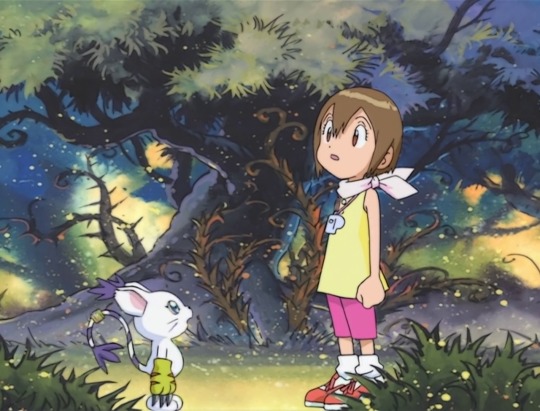
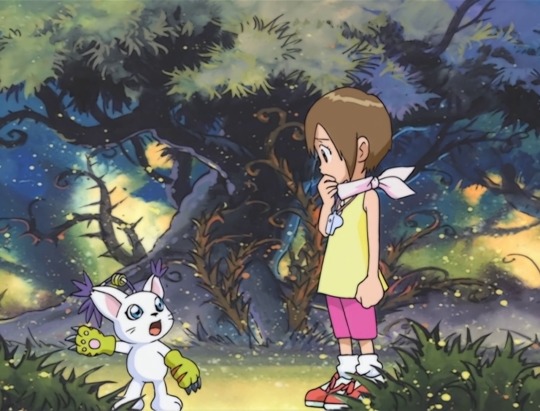
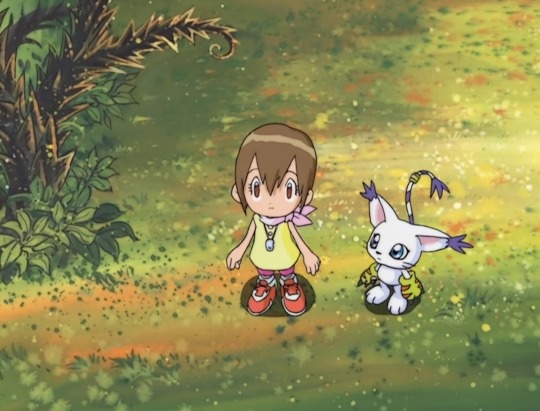

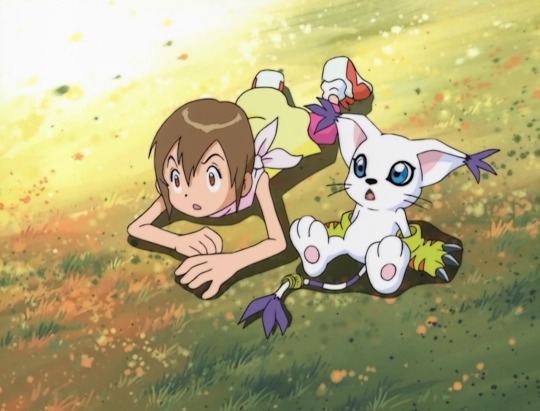
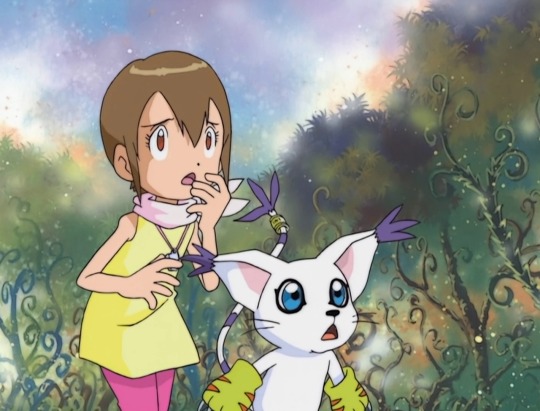
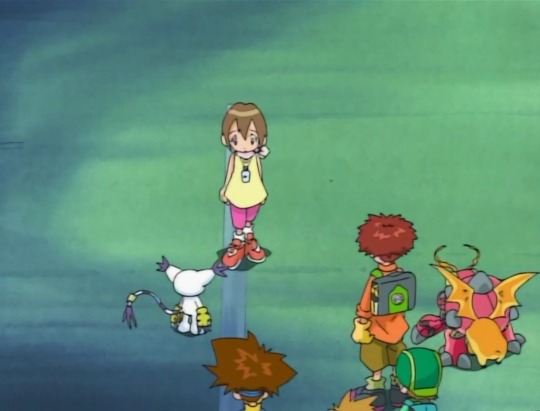

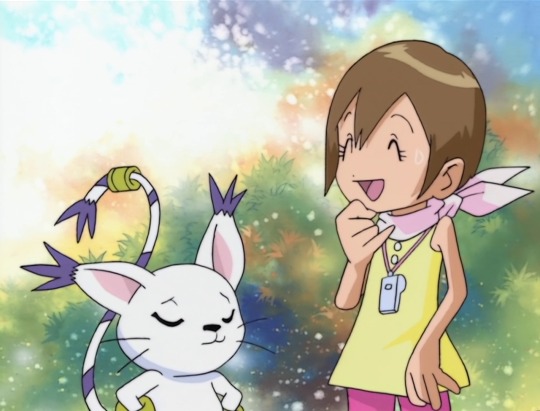
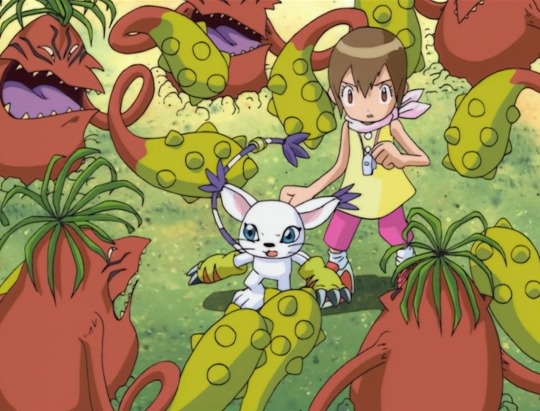
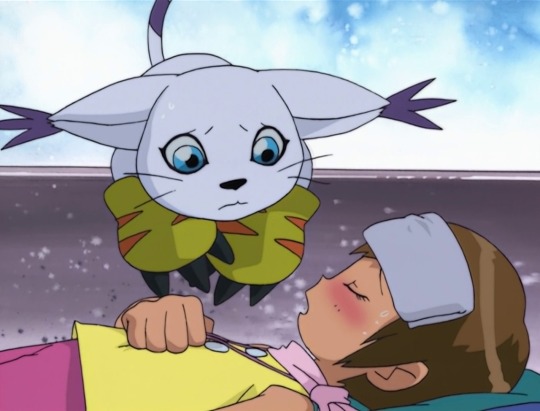
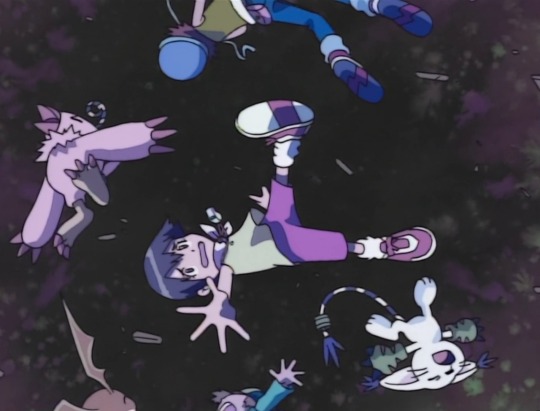

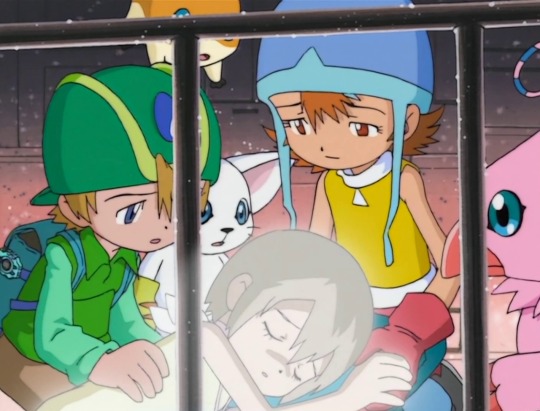
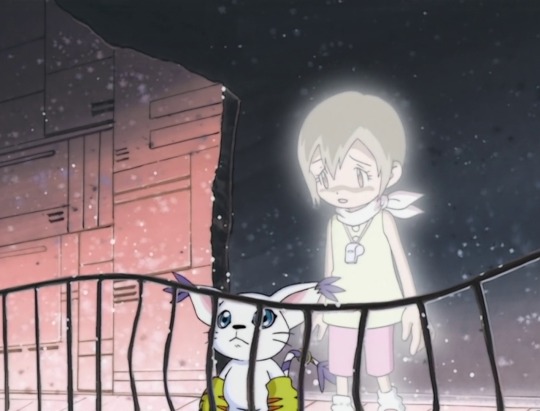
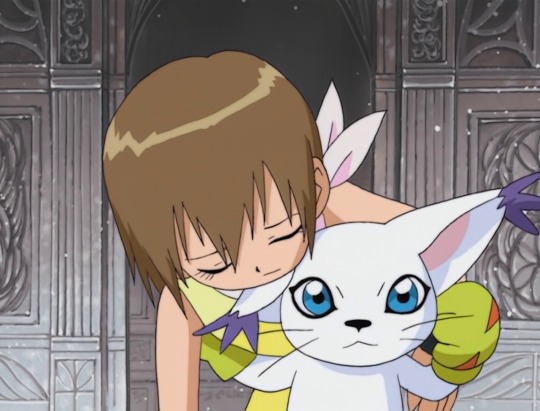

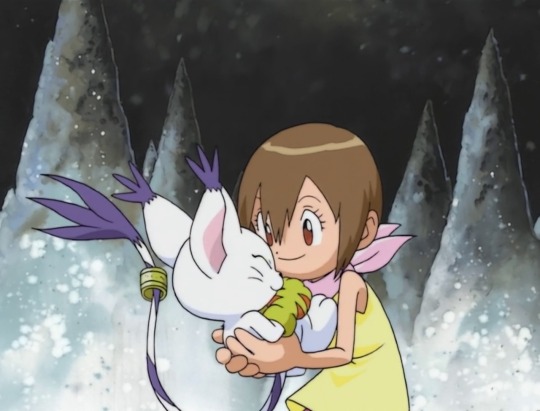
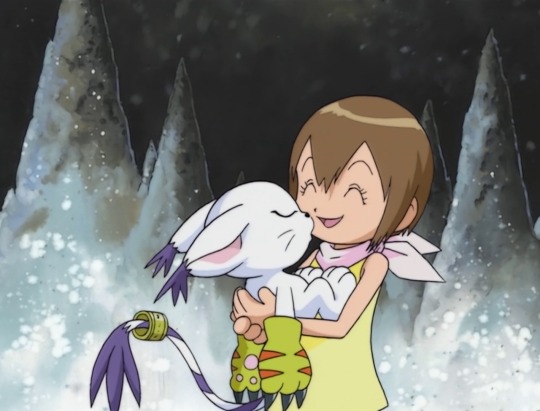

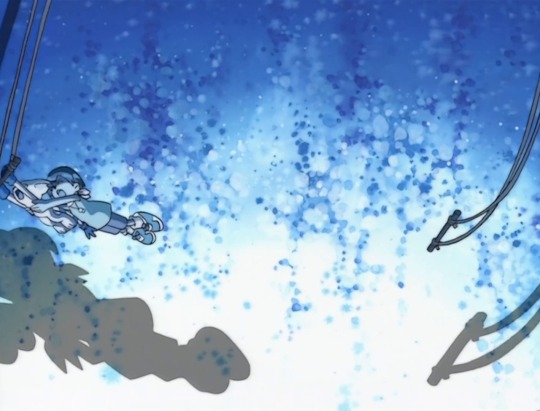
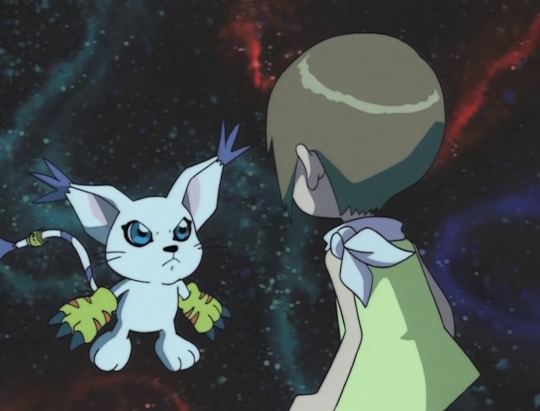
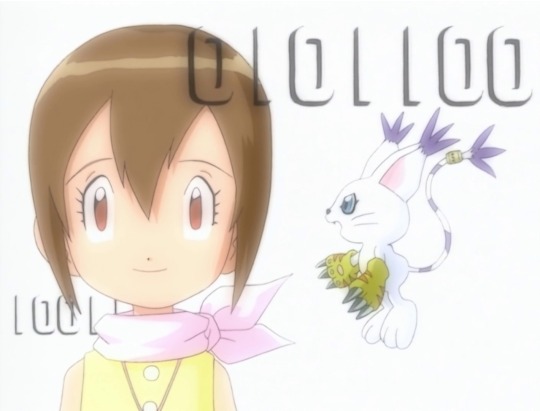

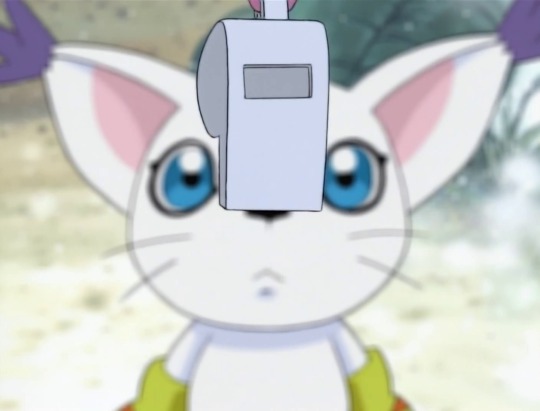
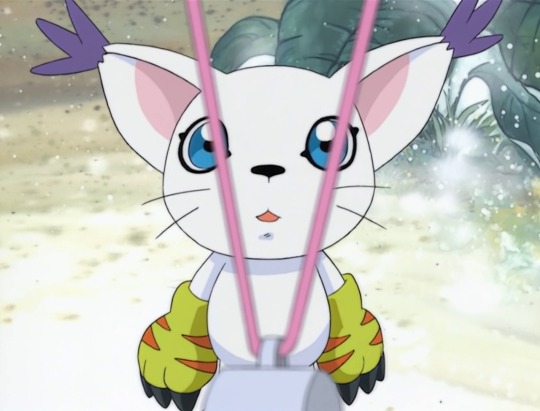
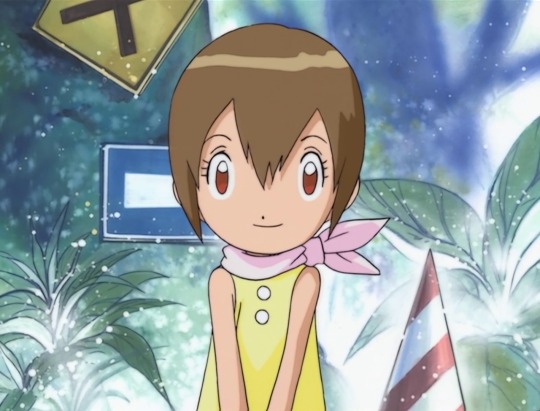
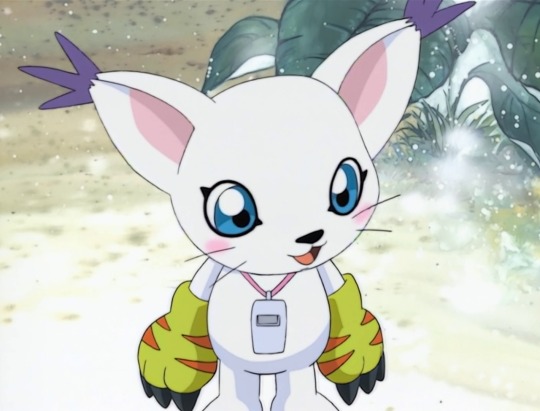
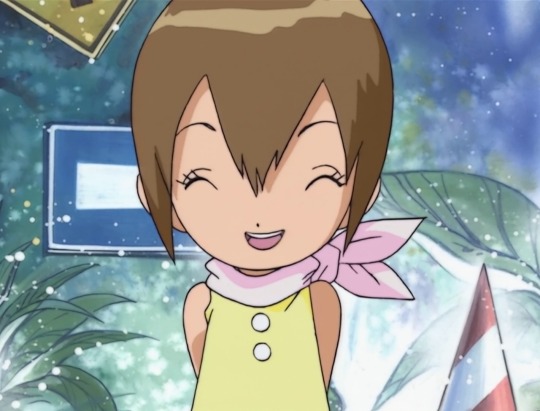
Hikari Yagami/Kari Kamiya and Tailmon/Gatomon in Digimon Adventure picspam 2
Also appearing in the picspam: Piyomon/Biyomon, Gomamon, Koushiro Izumi/Izzy, Patamon, Taichi Yagami/Tai Kamiya, Redvegiemon, Numemon, Sora Takenouchi and Takeru Takaishi/TK
Digimon Adventure episodes 43, 44, 45, 46, 47, 48, 49, 50, 52, 53 and 54
#Digimon Adventure#Hikari Yagami#kari kamiya#yagami hikari#Tailmon#gatomon#Digimon#piyomon#biyomon#gomamon#koushiro izumi#izzy izumi#patamon#redvegiemon#numemon#sora takenouchi#takeru takaishi#tk takaishi#picspam
67 notes
·
View notes
Text
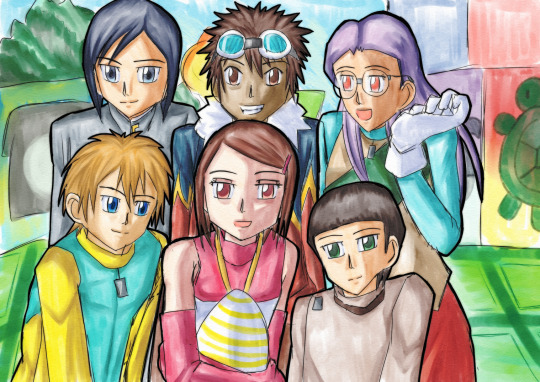
Digimon Adventure 02 Countdown Day 7: 02 Gang as a Unit
Among the places in Digital World, Village of Beginnings is one of the unvisited location for them (excluding Takeru, Hikari, and Ken for obvious reasons). 02 kids propose an idea to visit the said village someday.
And here they are, at Village of Beginnings. While Daisuke, Miyako, and Iori are having fun with the digitamas and newborn digimon babies, Takeru and Hikari reminisce about their past experiences in this place (mainly from Adventure era). Ken and Wormmon spend their time together in silence. Afterwards, the group engage in group photo (Hikari holding a digitama is a parallel of her younger self holding the said egg in Adventure Episode 54).
This happens a week after the final battle against BelialVamdemon and Digital World has been restored to original state (in most part).
Dedicated to @digimon02countdown
#digimon adventure 02#digimon02countdown#daisuke motomiya#miyako inoue#iori hida#takeru takaishi#hikari yagami#ken ichijouji#fanart
26 notes
·
View notes
Text
Number 8 of my Junimation countdown: Digimon Adventures.
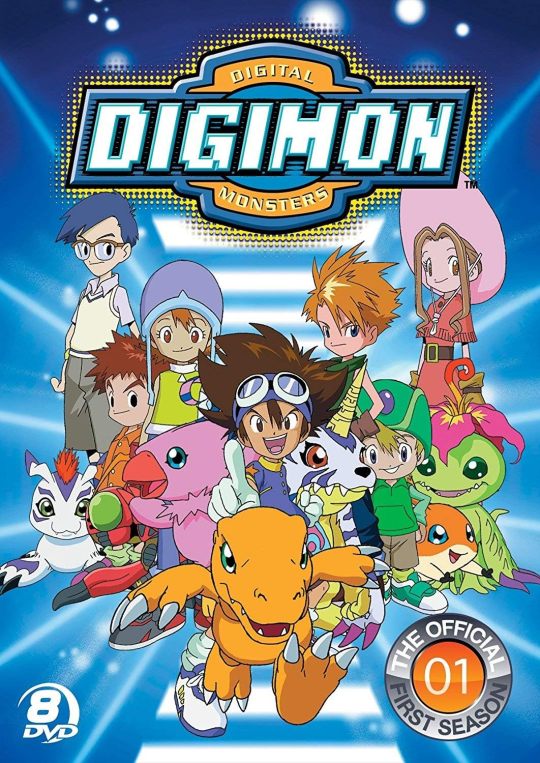
Show me your brave heart for these digital champions created by Akiyoshi Hongo. Technically might be one of the first Isekai's I have seen. The original series ran from the 7th of March 1999 to the 26th of March 2000 for a total of 54 episodes
The story is about 7 children who mysteriously got transported to another world inhabited by creatures called Digital Monsters aka Digimon. Surprisingly, the kids were already accompanied by their own Digimon who said they had been waiting for them. They also realized they are suddenly in possession of a gadget called a Digivice that can make their Digimon stronger through Digivolution. As their journey goes on, they learn they were Digidestined to save the digital world.
These digimon get stronger as their bond with their partner gets stronger. These growths and struggles keep this series interesting as you get to be hyped and engaged by the many Digimons and their Digivolutions. Even though I also like the Greymon and Garurumon Digivolution lines, my personal favourite Digimon design is Zudomon.
5 notes
·
View notes
Text
Nerd rant:
Some Marvel comic artist did a cool evolutionary line for 7 of the 8 original Digimon. I went hunting and found their twitter and looked for ages to see if they ever did Gatomon and there is ONE person replying asking if they did and the artist was like “I only did the original ones from season 1 🙏🏻”
Like first of all, Digimon Adventure and Digimon Adventure 02 are two different shows. Digimon Adventure only had ONE SEASON, 54 episodes. There were different arcs—the File Island arc, the Crest arc that culminated with Myotismon and the introduction of the eighth child, and then the Dark Masters arc.
So you just did one arc, BUT INCLUDED DIGIMON NOT INCLUDED UNTIL THE DARK MASTERS ARC AND SEVERAL THAT WERE NEVER INCLUDED IN THE SHOW BECAUSE ONLY AGUMON AND GABUMON MEGA-DIGIVOLVED
So it’s just the disrespect to Kairi and Gatomon. Gatomon first appeared in episode 27 SO SHE WAS IN HALF THE SERIES?????? And THEN featured the whole time in 02 because it was a continuation!!!!!
2 notes
·
View notes
Text
Since Hunters is mostly its own thing, we may need to go over Xros Wars proper, now that we covered all 54 episodes.
As we discussed before, until the last two Series, the first two Seasons of Xros Wars was the only Series as long as the original Adventure, as such, compared to other Series, this was the Series that defined a generation of Digimon fans.
However, due to poor reception of the final Season, Hunters, this is not a Series that define the franchise overall. Much like Frontier, it ultimately became its own oddity, despite the popularity of the first two Seasons, as Savers became defining not in TV series, but in video games.
We already discussed the inherent problems with DigiXrosing, and the finale of the second Series already made future power creep in the concept impossible. As such, conventional Jogress would ultimately return, as the more coherent means of combining multiple monsters.
We will go over things more throughly once we move to the Adventure reboot, though it is interesting point of discussion if Xros Wars would have had a better reception without Hunters.
0 notes
Text
Digimon Survive’s character cast, their roles in the group, and Adventure parallels
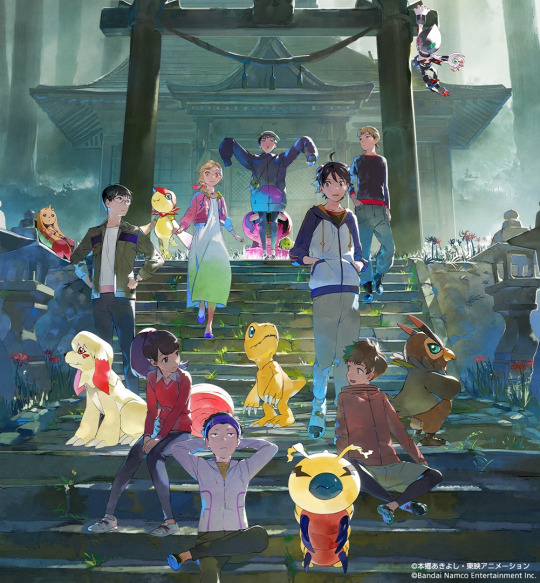
This franchise loves to self-reference, so it’s very easy to say that a lot of things are based on Adventure, but in Survive’s case, it has been abundantly clear (to the point of having been officially stated in many interviews) the narrative and setup itself is meant to be a reimagining of Digimon Adventure, as in the 54-episode series that aired from March 1999-2000. As much as the franchise likes to use Adventure symbolism, or rough glosses of its isekai premise, you might be surprised at how few things actually have bothered to take a look at the entire series and structure to the little things, trying to figure out what made it tick, instead of just pulling its names and faces and terminology and calling it a day. Moreover, one of Survive’s core premises of “a Digimon partner is effectively a part of your own soul” is a premise that originates directly from Adventure; it’s just that this time, it’s much more explicit.
Adventure is famous for being a character narrative, to the point you can put a picture with nothing but the characters and people will consider it representative of the entire series. So if you want to go deeply into Adventure, you have to look at its characters, what their relationships were, and what roles they had. And Survive does, but with its own distinct cast of characters who are very similar in some ways...and very different in others.
As you might expect, this post spoils all four routes, so please be aware of this before reading further. (I also will be spoiling Adventure and 02, in case you haven’t seen those yet. Hey, you never know.)
Because I wasn’t able to go back through all four routes to take screenshots, the screenshots used in this post are from Anthony (Wrathful), Owl-Quest (Harmony), and BattleBunny (Moral and Truthful)’s playthroughs. Please go check them out if you want to see the game yourself!
Something very important before we begin
I think making comparisons and drawing parallels is very useful, but I have a personal policy that comparisons should only be drawn “as much as they are useful” and no more than that. There’s a difference between “thoughtfully inspecting comparisons and contrasts to analyze how things work” versus “forcing parallels so hard that you end up trying to smash a square peg into a round hole, completely losing sight of the reason you’re trying to make those comparisons in the first place”. I know it’s tempting to try and make as many parallels as you can, but there’s a point where trying to force it becomes actively detrimental to your analysis.
It is true that Survive was built from the ground up as a reimagining of Adventure of sorts, and even promoted and officially stated to be such. However, Adventure is Adventure, and Survive is Survive. Survive is a game meant to stand on its own even if you've never touched Digimon Adventure in your life; to act as if the narrative and characters are nothing more than variations on Adventure’s is, in my opinion, disrespecting Survive’s efforts to be its own story in the end. It is a game that pays tribute to and reimagines Adventure's concepts, so it can't (and shouldn’t) be disentangled completely from Adventure if you want to bring the most out of an analysis, but it’s also unfair to treat the game as if it’s just some kind of twisted, barely-modified parody of Adventure, because it’s not. It’s a game that draws heavily from its predecessors in bringing up concepts to think about while also firmly doing what it needs to do in order to be its own story.
Therefore, in making character comparisons and analyzing the characters in relevance to Adventure characters, my priority will be on making connections between “their roles and positions in the group” rather than trying to force comparisons for the sake of forcing them, or trying to claim that this character is just the Survive version of this Adventure character. In fact, in some cases, my goal is to convey that a Survive character may start off in the same rough position as their Adventure counterpart but go in a very different direction.
I also would like to reiterate that I very much disapprove of the idea of using Survive to be condescending about Adventure. Survive’s characters and plot do address territory that Adventure isn’t able to, but framing Survive with reductive things like “Adventure but darker/edgier” or “a deconstruction of Adventure” as if the game only exists to dunk on Adventure’s idealism or treat it like it’s implausible is incredibly disrespectful, not only to Adventure but also to Survive, which in fact very obviously holds its predecessor in high esteem. (I mean, it is very fun to refer to Survive as “Adventure except people die” as a joke, but the game really is more than just that.) I’m going to bring back this very well-worded tweet “a deconstruction is when I like something in a genre I disrespect”; I don’t have any patience for this kind of thing, so don’t bring it in here. I reiterate: the comparisons are going to be drawn for the sake of better analyzing what Survive is pulling from and referencing while also doing its own thing for its own story. No more, no less.
Takuma and Agumon

At this point it’s pretty much common knowledge that anyone with a name that starts with “ta-” and a pair of goggles is going to be taking Taichi’s role as protagonist, and Takuma having an Agumon only drives it in further, but if we’re actually going to talk about Taichi himself, things get a little more complicated because Taichi was actually quite unusual in many ways (I honestly would say that Taichi is a character a lot of people “know” but don’t tend to easily “understand”). But right off the bat, Takuma turns out to have a very different temperament from Taichi’s, being significantly more introspective and less impulsive. In fact, he holds the distinction of being a rare Digimon protagonist who uses the polite first-person pronoun boku (most Digimon protagonists use the more assertive ore), and for frame of reference, the other major players who do this are Takato (Tamers), Haru (Appmon), and Keisuke (Hacker’s Memory), all three of whom are associated with some kind of meta element questioning whether they should be in the protagonist position...
(Personally, between Takato, Haru, and Keisuke, I’d say Takuma is probably closest to Haru in that he’s polite but also very thoughtful and introspective. He does happen to have self-doubts much more quickly than Haru would most of the time, but he’s not prone to Keisuke’s self-esteem issues or Takato’s tendency to shrink easily.)
Some of the nuances of Takuma’s personality and how selfish or selfless he is depend on the player’s choices and what route things are in, but for the most part the general core is consistent across all four routes. Takuma doesn’t start off thinking of himself as the group’s leader, and this part is consistent with Taichi as well; Taichi didn’t have particular awareness of himself as the group’s leader until Jou confronted him with the prospect in Adventure episode 28. However, in contrast to Taichi immediately taking initiative and pulling everyone forward even if he didn’t consciously see himself as the leader, Takuma started off still having strong awareness of seniors like Aoi and Shuuji, and it only slowly becomes apparent that he’s taking charge as more and more characters start pointing it out, culminating in multiple characters pretty much unanimously considering Takuma the group’s leader even before he’s considered it; Part 9 on the Truthful route has Shuuji outright admit to Ryo that he’s using Takuma as his model for how a leader should actually be.
So how does Takuma end up becoming unanimously considered the leader in a similar way to Taichi despite having such a different temperament? The characters spell it out in clear words multiple times over the course of the game: he brings the group together by being their emotional center. That part about being their “emotional center” is important because Taichi wasn’t necessarily as good at that part (which incites a lot of conflict between him and the others during the last arc of Adventure), but the reason this is more important for Takuma is that the Survive group is significantly more prone to infighting than the Adventure group was most of the time. When the game’s producer Habu called it the “Lord of the Flies” counterpart to Adventure’s “Two Years’ Vacation”, Adventure’s director Kakudou revealed that Lord of the Flies was an inspiration for the part of the story corresponding to Pinocchimon and Yamato...which resulted in Taichi failing to keep the group together and everyone falling apart. So in other words, Takuma is pulling off the achievement of keeping the group glued together when the equivalent of the Pinocchimon arc is happening all the time. There are no Crests in this narrative, meaning the automatic filtering for “naturally good kids” was absent and the kids were dragged into the Digimon world by sheer virtue of being in the wrong place at the wrong time, leading to a lot more negativity on all fronts and composures lost much more easily -- and thus, Takuma’s ability to keep a cool head and get everyone to calm down becomes his most important asset.
Also of note is Takuma’s own relationship with Agumon. While Agumon in this game is obviously based off Taichi’s Agumon in Adventure, Takuma and Agumon end up having quite a lot of conversations together where Takuma consults with him on how to sort out his emotions and what to do next, far more so than would happen in the original Adventure. Part of this is simply because of the medium shift (being a video game, Survive is able to have much longer conversations that aren’t restricted by timeslot airtime), and it’s also not like Agumon in Adventure wasn’t also emotionally insightful when Taichi needed advice, but Takuma and his Agumon partner end up having several conversations on the vein of Adventure!Agumon’s discussions with BlackWarGreymon in 02 episodes 32 and 46. In the end, the main reason is probably just that Takuma is just that kind of introspective person who actively seeks out Agumon and talks to him honestly, allowing them to get borderline philosophical without any strings attached.
Minoru and Falcomon

The mere suggestion that Minoru is supposed to be Koushirou’s counterpart would probably make someone roll their eyes and go “oh, come on, now you’re really forcing it,” and I wouldn’t blame anyone for thinking so. Temperament-wise, Minoru couldn’t be any more different from Koushirou. Rather than anyone in the Adventure group, he comes off as a kind of mix of Daisuke (in terms of being rough but friendly and having a forward-thinking attitude) and Miyako (in terms of being a “mood maker” who tries to keep everyone’s spirits up but needs to be reined in by a more stoic partner). But trust me, hear me out, I know this sounds weird, but I’ve got more reason for this stance than you might think!
Actually, Koushirou had a pretty complex role in Adventure, to the point he seems to have two counterparts in Survive. The more well-publicized parts of Koushirou’s profile involve his intellectual curiosity (bringing him closest to the secrets behind the Digital World) and his sense of deference and politeness, and those traits correspond more to the Professor (more on that when we get to his section). However, the less well-publicized but no less important part is that Koushirou was, for all intents and purposes, Taichi’s right-hand man, and thus one of the most important figures in helping Taichi pull off what he needed to as leader.

Koushirou was one of the few kids who knew Taichi prior to the events of the series and had already established a certain sense of respect for him (he only went to camp at all because of Taichi). As a result, while Koushirou tended to avoid confrontation with the others in the group, he was open to Taichi in a way he often wasn’t with others, and Taichi likewise was comfortable asking him for assistance (culminating in the famous moment in Adventure episode 28 when Taichi uses his authority as leader to appoint Koushirou as the best person to solve the card puzzle). Later, it’s Koushirou who sticks by Taichi when the group splits up during the Dark Masters arc, Koushirou who witnesses and hears out Taichi during one of his biggest emotional breakdowns in Adventure episode 48, and Koushirou who works directly alongside Taichi in Our War Game! Taichi’s relationships with Yamato or Sora tend to be more well-publicized, so casual fans of Adventure or mainstream media reports tend to completely gloss over this, but it’s conspicuous to anyone who knows Adventure on a particularly deep level. (While this analysis sticks purely to the original Adventure and 02 for the sake of consistent scope, it says something that even stage play writer Tani Kenichi clearly also caught onto this and had the lines "I've watched you at your side all these years! Isn't that right?!" and "But I thought you could at least speak honestly with me!" come out of Koushirou’s mouth.)
So as much as Minoru isn’t really much of a counterpart to Koushirou in terms of personality, he is in terms of Koushirou’s “position in the group”: the leader’s right-hand man who avoids inciting confrontation but is vital in helping keep them together. (In fact, the part about avoiding confrontation is pointed out quite directly in his official profile.) Considering how Takuma pulling off the feat of keeping everyone together required him to have a very different temperament from Taichi, it thus follows that Minoru’s temperament needs to be different from Koushirou’s in order to achieve the same effect with the Survive group. Koushirou’s more polite and level-headed demeanor was important to keeping the rather impulsive Taichi in check, but in this case, Takuma is already plenty level-headed by himself, and Minoru being more actively sociable and trying to keep everyone’s spirits up is a more effective complement. This is helped by the fact that, in the same way Koushirou knew Taichi from the soccer club even prior to Adventure, Minoru happens to have already been Takuma’s friend from school prior to Survive, and thus by the time we get to the final chapters of the game (especially in the Truthful route), it’s made quite clear that Minoru really is Takuma’s right-hand man whom he can rely on for many things. On top of that, Minoru being so agreeable makes him the only character of the group besides Takuma to survive all four routes -- he sticks by Takuma no matter what.
Background-wise, Minoru’s is quite different from Koushirou’s in that he’s mostly used to being rather lonely at home due to a divorced father and a workaholic mother, and he also happens to be a fan of hero manga and tokusatsu to the point a lot of his personal ideal throughout the game is to become a “hero”. (Perhaps fittingly, his temperament is probably the closest to the shounen protagonist archetype among this group.) This puts him in an interesting position in that he’s the most aware of what kind of heroic character would be from a series like Digimon Adventure and personally strives to be one, even though it takes him a while to gather up the courage for it. When you have affinity-affecting choices with him, he tends to prefer the “forward-thinking” kinds of responses that would make Daisuke proud, so he clearly took the kids’ media lessons to heart. In line with that, Minoru is the only character besides Takuma to survive all four routes; while his biggest emotional turmoil happens in all four routes (it takes up the majority of Part 6), he and Falcomon weather through it quite well. But when you think about it, back in the Adventure universe, the kids who admired the Adventure kids most were...well, the 02 kids, so perhaps it’s not actually that surprising Minoru’s temperament is closer to them.
Also, here’s another fun thing to consider: Minoru’s dynamic with Falcomon takes several pages from Miyako and Hawkmon’s book...so, remember who also happened to be Koushirou’s junior who admired him the most?
Aoi and Labramon

If you wrote a rough base outline of Sora and Aoi’s characters, they’d probably be pretty similar or even identical. You’d basically get something like “the Mom Friend who tries to take care of everyone and overwhelms herself in the process, crumbling under the pressure”. But there is one key distinction that makes all the difference: Sora’s desire to help others was something that came naturally to her despite her own lack of self-awareness, whereas Aoi’s woes come from the fact she’s all too aware of the fact everyone is relying on her and bears resentment about it.
One recurring thing with Sora was that her own self-evaluation was often much harsher than she actually deserved. Initially scoffing at the idea of being responsible for someone else (Adventure episode 4), despite being unable to abandon everyone and constantly going out of her way to help everyone behind the scenes (Adventure episodes 22-25), her own self-evaluation was still that she was apparently devoid of love and didn’t care about the others at all (Adventure episode 26). Her constant desire to help everyone was effectively compulsive, and she had poor awareness of whether she was getting in over her head, with others needing to remind her that she shouldn’t see things as an obligation (Adventure episode 51). Sora was barely even aware of how much she was putting out for others because she saw it as an impulsive obligation, and the others were the ones concerned about whether she was taking enough care of herself. Moreover, although Sora bottled up quite a bit of self-imposed pressure, she wasn’t exactly shy about expressing her feelings; it’s just that they often happened to be messy, and she wasn’t sure what to make of them.
(By the way, this is also why I really don’t like the idea that Adventure is somehow more “unrealistic” or even “idealized” than Survive’s just because they’re ostensibly more put-together and selfless people, because Adventure’s characters often toed on the other extreme of being selfless to self-destructive levels; the kids would be prone to severe self-confidence issues or even self-hatred, especially going into 02. While the Survive kids may seem overall self-centered at first and thus be more prone to infighting, any self-worth issues they have or attempts at reckless self-sacrifice don’t tend to be as frequent or extreme as they were with the Adventure and 02 kids.)
In contrast, Aoi is consciously aware of what’s on her plate, what she’s dealing with, and why she’s doing what she does. Sora was the same age as Taichi and Yamato, so she was able to be comfortable in a position as their peer, but Aoi is one year older than Takuma and therefore considered one of the seniors of the group, a fact that’s alluded to multiple times over the course of the game. This means the group ends up treating her with the expectation that she has responsibility for them (especially after Ryo and Shuuji die in the main routes, thus genuinely leaving her as the oldest one there), and on top of her class president duties, she’s surrounded by expectations and responsibilities that are actually imposed on her. On top of that, people actually take advantage of her kindness and exploit her, and she knows this fact very well and hates it. (While it’s possible this might have happened with Sora, it’s unlikely she would have even realized she was being taken advantage of, much less come to resent anyone who did, because the issue was more about her own difficulty with setting boundaries and doing something for herself.)
Aoi does what she does because “she wants to be helpful”, so she suppresses all of her angry feelings and resentment to not burden anyone; for the early parts of the game, Labramon openly voices all of the snark and harsh burns that Aoi clearly wants to say but won’t. This means that meeting Saki inspires a mix of admiration and envy for the fact Saki is able to express her feelings so openly. But in the Wrathful route, when everything goes to hell and Saki (somewhat) sacrifices herself for Aoi, Aoi implodes from the resentment of everyone burdening her with responsibilities, seeing their attempts to give her space as not caring enough about her, and upset that after all of her desire to be “helpful”, everything actually just got worse. The last straw is when Piemon exploits her kindness to attempt to murder her, and the end result is Aoi completely flipping into “the ultimate selfishness” (absorbing Labramon, as in her own ego) to decide that the best solution would be to impose her way -- the way she’d never been getting all of this time -- on others and force them to agree with her.
Thankfully, Aoi fares better in the other routes where she manages to trust and rely on others a little more, and her friends do much more to make sure she knows her efforts are appreciated. Notably, during her affinity choices, Aoi reacts very well to choices that validate her right to have “shallow” interests like cute things (instead of it being considered undignified and immature of her) and choices that have other characters outright call her a Mom Friend. I’m pointing this out because for all Sora is well-known among fans for being a Mom Friend, this wasn’t actually pointed out with this kind of wording in Adventure mainly because Sora wasn’t really seeing herself as one, but here Aoi does prefer to be seen this way, presumably because it affirms the fact her friends appreciate her as a person rather than someone to dump responsibilities on.
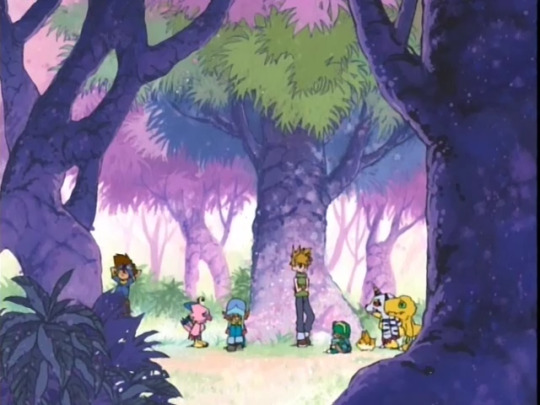
As an aside, the Wrathful route involves a subplot about Kaito being one of the first to catch onto what’s going on with Aoi and make the most prominent attempt at reaching out to her, and while I don’t know if this was intentionally meant as a parallel, it does call back to the scene in Adventure episode 26 when Taichi and Yamato are at a loss as to how to help Sora during her emotional meltdown, and Yamato’s response (to let her cry if she needs to) is indicated as the better option until Takeru finally manages to step in with the best response. In Aoi’s case, given that she ends up resenting everyone giving her space (interpreting it as “leaving her alone”), Kaito’s attempt to get through to her by confronting her directly about her feelings was probably the closest to a step in the right direction -- it’s just that unfortunately Kaito doesn’t exactly handle it delicately enough to prevent Aoi from having a complete breakdown.
Fortunately, as if responding directly to this predicament, the Moral route contains a scene of them getting along perfectly well when going out to get food together. This is significant if you played Wrathful and Harmony before then, because both routes had one or the other fall off the deep end; Moral has Shuuji and Ryo’s deaths force them to step up to the plate, but without the exacerbating factors that drove both to to the brink in Wrathful and Harmony, it turns out they’re more than capable of stepping up to the task.
Ryo and Kunemon

While it’s generally easy to figure out at least some obvious parallels for each character in this cast, sometimes even multiple, Ryo is the one character I’ve never seen anyone really be able to get a read on regarding this question. I’ve seen suggestions that it might be Akiyama Ryou (based on the name) or even Ken (based on having a bug-type partner that he initially had a bad relationship with). Personally, my stance is “nobody, and that’s the point” -- because you’ll notice that the one thing all of these theories have in common is that none of them correspond to anyone in the original group from Digimon Adventure.
I’m not sure if this really comes across as well to anyone who hasn’t actually played the game hands-on, but one very striking thing about Ryo over the course of the beginning of Survive is that the game oftentimes feels like it’s tempting you to give up on him. The characters label him as unlikely to be cooperative right off the bat, and while they extend the minimum amount of courtesy to him, it’s also tinted with a sentiment that nobody really expects him to come along because he’s so pessimistic he’ll never cooperate. Getting his affinity level up to a significant amount in the early game actually requires you to go out of your way to seek him out and talk to him at least once (during a period the game interface doesn’t inform you that he’s available to talk like it does the other characters). And Ryo really is an uncooperative stick in the mud who doesn't look like he has any interest in helping himself anyway. They spoiled the fact he was going to be the first death before the game even released!
In other words, Ryo has no clear Adventure counterpart because “he has no place here”. He’s not a character who fits in the framework of Adventure-defined archetypes. He wasn’t made to be on a heroic adventure to begin with, and so he’s the first to be removed from it. And yet, the difference his presence or absence makes results in him being arguably one of the most important characters in this game.
In fact, even in the very, very early stages on the game, there were hints that Ryo’s behavior of being completely uncooperative and pessimistic were largely exacerbated by the stress of being brought to another world with monsters; if you closely watch him at the beginning of the game, he’s the one who enables Miu into taking them to the shrine (which he reminds us about near the end of the Truthful route). His website short story reveals that he’d actively decided to go to the extracurricular camp despite his initial misgivings because he really did want at least a little hope of making friends. But being jaded from isolation does a number on your abrasiveness level (the Frontier kids can testify to that one), and then everything went to hell when all of his stress factors and feelings of isolation were aggravated to their worst.
Depression isn’t an elegant thing, unfortunately, and Ryo’s inner desire to do better being blocked off by his initial difficulty to connect with others is perfectly exemplified by Kunemon trying really hard to take care of Ryo and communicate with others but being held back by his inability to use human language or do much with his limited physique. Note that Ryo’s initial hostile behavior towards Kunemon isn’t necessarily condescension or anything near the level of Shuuji’s initial bad relationship with Lopmon; it’s just that Ryo is afraid of Kunemon and not sure what to make of him, in the same way he’s clearly not sure what to make of himself. (Naturally, the first thing Ryo does when he comes back from the brink is start forming a proper relationship wtih Kunemon, and Ryo himself opening up more in the Truthful route correlates with Kunemon’s higher forms becoming able to speak.)
Ryo’s death in the three main routes is from a mixture of factors that even the cast in-universe isn’t sure what to make of; he doesn’t actively commit suicide per se, but his death wouldn’t have happened if not for his extreme suicidal ideation, and while Takuma regrets not having reached out to him earlier, it’s also not like he can be blamed for not doing enough when it wasn’t for lack of trying (from Takuma’s perspective, it’s not like he had any way of knowing that Ryo would die if he didn’t bond with him intimately in 3 chapters, and Ryo himself wasn’t exactly giving much of an indication that such a feat would actually be possible). Looking at the difference between the routes where he dies and the route where he doesn’t, the difference is that when Ryo dies, his pessimism about anything working out for him and him having a “place” anywhere convinces him he really doesn’t have anything to live for anymore, whereas the route where he lives has Takuma and the others so obviously risking life and limb to drag him back that he’s actually able to see, very clearly, that he did have a “place” and the ability to make friends after all.
(By the way, I should point out that one thing Survive is very good at is that a lot of the “correct” affinity choices are ones where you don’t pry too deeply into their problems and instead respect the other person’s space. In Ryo’s case, getting his affinity up quickly enough to save him requires going out of your way to check on him often, but the actual choices that raise affinity mostly involve validating his feelings and not prodding things too much, basically showing that you care but also respecting that he’ll open up when he’s ready.)
Having realized this, Ryo opens up immediately; again, he was interested in proactively making friends from the get-go, so it’s only natural that as soon as he confirmed that was a possibility for him and his initial shell was broken through, he didn’t hesitate to brighten up and actively engage with the others. Turns out, he's actually one of the most emotionally insighful people in the cast (in no part because, as someone who's seen the bottom, he's well aware of its horrors), but he also has a certain sense of grounded, to-the-point pragmatism while also not being as extremely emotionally charged as Kaito. Completely contrary to the bad first impression he gave everyone (except Saki), it turns out he’s actually a pretty great friend to have. And once Ryo is saved, the route automatically locks onto Truthful, because it creates a chain reaction where he ends up being the best person to save Shuuji, who then paves the way for the truth to be reached and the best possible ending achieved.
Remember how I said that Ryo was the character who had no place in the Adventure framework? If Ryo dies in Part 3, the “best” possible ending you can theoretically get (Moral) is the one that correlates most closely to Digimon Adventure, with the kids being booted out of the Digimon world for the time being and an uncertain future of whether the worlds can truly come together. Reaching an even better one that more closely represents what came after Adventure and allows the story to be passed onto future generations (very unsubtly represented by the Chibimon meeting new kids at the end -- note the significance because none of the 02 quartet’s Digimon are recruitable in the game) requires Ryo, the added factor who helps the story proceed.
But really, the ultimate take-home the game is making here is that you shouldn’t give up on people that easily, because they just might surprise you.
Saki and Floramon
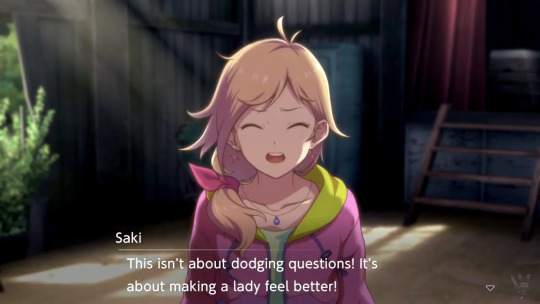
Saki’s creed being to “go with her feelings” makes it immediately obvious off the bat that she’s the Survive counterpart for Mimi, but interestingly, Saki is simultaneously more rude and more kind than Mimi was in Adventure. Mimi had a “princess-like” demeanor based on her somewhat spoiled upbringing, meaning that on one hand she would be quick to complain and gripe about anything that even moderately annoyed her, but she also was constantly deferential and respectful to her elders, had consistent use of honorifics, and was always polite and careful not to step on anyone’s toes as long as she wasn’t emotionally overwhelmed.
On the flip side, Saki handles everyone somewhat bluntly (not even using upward-facing honorifics for most characters despite being one of the youngest in the group) and has less regard for what other people think when she says what she feels -- but she’s quite the opposite of spoiled. In fact, Takuma realizes after a fashion that she comes off as someone who’s been through hardship in the past, and she’s actually one of the most resilient in the cast; eventually, we find out that any “sheltering” she’s been through comes from the fact she wasn’t allowed to do much in light of her illness, and her emphasis on feelings and living to the fullest comes from the fact she’s not sure whether she might die soon. Moreover, the illusory versions of Saki encountered over the course of the game reveal that she’s actually afraid of being hated by others, so there is a certain aspect of her that’s self-conscious about whether she’s going too far.
In the end, Saki respects others’ feelings, but also expects to have her own feelings respected in turn. Throughout her affinity events, Takuma learns that although she initially seems flighty and difficult to predict in terms of how she wants to be treated, she’s a lot more considerate than she seems at first, and at no point does she deny anyone else’s right to feel the way they do as long as they respect her own. In addition, while she doesn’t believe in hiding how she feels, she also does take measures to try not to step on others’ toes (that is to say, she understands that she can’t just selfishly do whatever she wants without regard for others). Out of all of the deaths presented in the three main routes, Saki’s is perhaps the most purely selfless one as she knowingly accepts death in the face of her fear of it, as long as it saves others -- especially since the weight of “failing” her friends hangs so over her head that she loses all sense of self-worth.
The beginning of Part 5 of the Wrathful route reveals that Saki had been delaying a surgery out of fear of its outcome, despite the fact that it would greatly increase her chance of living longer if she takes it. It’s left ambiguous whether she does actually decide to commit to it after the events of the game, but the three endings where she survives (Harmony, Moral, and Truthful) confirm she at least lives for a year after the game’s events. One can only hope that the events of the game and her friends convinced her to have the courage to take it!
Incidentally, Adventure and 02 generally had a pattern that the characters with Digimon partners that were closest to their own personalities were the ones that usually were more straightforward -- so naturally, Saki and Floramon have the closest to identical temperaments from the very beginning.
Shuuji and Lopmon

Considering that Jou tends to be one of the most well-liked Adventure characters by adult fans, depending on how you look at it, it’s either deeply ironic or incredibly fitting (or both) that his Survive counterpart is turning out to probably be the most controversial character in the cast.
In fact, on the surface level, Shuuji’s profile is almost identical to Jou’s from temperament to backstory. He’s the oldest of the group (in this case, the only one in high school) and is therefore considered the “leader” with responsibility for everyone by default, but doesn’t really have the mettle to keep himself together for it at first. His sense of duty has roots in his family life, including a father who has high expectations of him and a shadow of an older brother looming over him. However, one factor makes all the difference here: Shuuji’s doing all of this specifically because he wants to please others and get their approval.
Jou wasn’t really all that worried about what others thought of him (other than the minimum amount of respect necessary to have faith in his ability to keep them together). The concept of “status” didn’t really play any sort of factor, and in fact, he was portrayed as even somewhat dragging his feet when it came to studies or social status. On top of that, poking into a 02 drama CD reveals that Jou’s dad wasn’t actually that controlling, and was perfectly willing to give his blessing to Jou about not becoming a doctor; it’s just that Jou knew that, emotionally speaking, he wouldn’t be very happy about it, so Jou was doing this because he just really cared about his dad’s feelings. Jou only didn't want to "disappoint" others because he happened to have a Good Samaritan nature of wanting to help others, and in fact it almost seemed he thought of himself too little to the point of having a rather recklessly self-sacrificial streak (Adventure episodes 7, 23, 36). When Jou said “because I’m the oldest”, what it meant was “because as the oldest, I take my responsibility to take care of everyone very seriously”.

In contrast, Shuuji’s fixation with being respected as the “leader” is decidedly less altruistic than Jou’s, and in contrast to Jou not really worrying that much about what others think of him, Shuuji believes he’s entitled to everyone’s respect and acts out of fear of abandonment. Of course, the beginning of Part 5 makes it clear why there’s such a huge difference here: instead of a father who was still ultimately supportive despite everything and two older brothers who looked out for him, Shuujii’s father is emotionally abusive, and while his brother doesn’t seem actively condescending per se, he seems to have a sense of resigned apathy and is only driving Shuuji’s inferiority complex in further. (While it wasn’t said in Adventure or 02 that Jou was necessarily concerned about being compared to his older brothers, there was a nuance Jou had a very intimidating “example” set by his university-aged brothers -- but that's also exactly why Shin pulled Jou aside to give him advice in Adventure episode 38.) With the fear of being "abandoned" instilled in him, Shuuji desperately tries to prove to everyone around him that he's capable of being a "leader", but his obsession with trying to force everyone's respect rather than doing anything actually worthy of it only earns him less respect, which he knows...leading to a very bad loop.
Shuuji's behavior of being a well-meaning abuse victim who ends up exhibiting abusive behavior as a maladaptive response to his trauma is unfortunately a very well-known cycle, especially in the way it manifests via his behavior towards Lopmon. In a moment of clarity at the beginning of Part 5, Shuuji does notice that Lopmon's behavior towards him mirrors his own behavior towards his father, but this only results in a slight improvement in their relationship (from “treating him like a disgusting monster” to “overworking him to uncomfortable extents”), with Shuuji treating Lopmon in the exact same way his own father treated him. If you know anything about typical maladaptive trauma behavior, it comes out most prominently when the person in question feels the safest -- when they feel threatened, they shrink under the trauma, and when they feel safe, they try to make use of the control of the situation they’d so desperately been lacking, resulting in them resorting to the only thing they know how to do. So ironically, Shuuji began behaving this way because he actually felt emotionally safer with the kids and with Lopmon than he did at home; in front of his family, he shrank and groveled at his father’s feet, but once he was in a situation he did have an opportunity for respect, he became overly controlling.
In three of the four routes, Shuuji dies a vicious and unfortunate death when his own negativity dark evolves (for lack of a better way to put it) Lopmon and symbolically results in him being destroyed by his own malice, but in the Truthful route, Ryo gives him a good smack in the face to bring him back to his senses. While it's implied that Ryo was in the best position to understand how necessary that was due to having personally experienced trauma himself, at the same time, it's also remarkable just how quickly Shuuji bounces back and completely changes his tune thereafter. In fact, it’s quite unlikely Shuuji himself wanted to be this kind of person, it’s just that this kind of behavior was the only way he knew how to respond. (Note the symbolism of Wendimon himself clearly being in anguish and effectively crying for help even after devouring Shuuji -- he was afraid of his own destructive qualities.) Even if Shuuji wasn’t necessarily dealing with a supernaturally implanted ball of darkness in the back of his neck, it is not entirely off to be making a comparison with Ichijouji Ken.
Shuuji’s role in helping achieve the Truthful outcome happens because he decides to become the Professor’s assistant, meaning that Shuuji is actually incredibly capable and intelligent to the point where his observations help the Professor reach a level of understanding he wouldn’t have been able to otherwise. Shuuji himself says that he decided to start working under the Professor because he wanted an adult’s example to follow, which is important because this is basically Shuuji realizing that the other adults in his life had failed him. For all his father gave him grief for being a bad leader, he wasn’t exactly setting a fantastic example himself about what a good leader should be, and Takuma notes that Shuuji is starting to take on some actual leadership qualities just by being more confident and being more assured of what he wants. Shuuji says that he’ll talk to his father and brother once he gets back, and it’s not entirely clear whether this will go well (personally, I’m willing to put more bets on his brother, whom I imagine is likely to be a victim of their father as much as Shuuji is), but the important part is that this will mean Shuuji asserting himself and what he wants back at his family, pursuing what he wants to do and being a leader figure in his own way, rather than doing things just because his family expects him to.

It took a much longer and much more painful way to get there, but Shuuji was able to come to a forward-thinking conclusion for himself not entirely unlike the one Jou reached at the end of Adventure, which I think is pretty neat.
Kaito and Dracmon, Miu and Syakomon
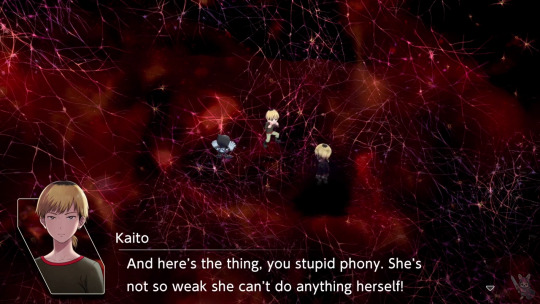

Kaito and Miu’s character stories are so intertwined that I honestly feel it would be better to combine their sections here (I also know Miu would probably hate this, so I give my deepest apologies to her). Of course, it probably goes without saying that they’re Survive’s parallels to Yamato and Takeru, in the form of an overprotective older brother and a younger sibling who wants to be more independent. However, Yamato and Takeru’s situation was heavily influenced by their family situation, which is very different from Kaito and Miu’s, resulting in some pretty significant differences.
Back in Adventure, Yamato and Takeru’s parents having divorced meant that the brothers only got to see each other once a year (Yamato jokingly compares it to Tanabata in 02 episode 17), and Takeru had gotten his parents to agree to let him join Yamato’s camp despite not even going to his school. Thus, Takeru was openly affectionate with his brother because he was happy to even have the chance to be with him at all, and Yamato was overprotective because he didn’t have very many opportunities to do much for Takeru to begin with. Both of them were still heavily hurt by the divorce and coping with it in ways that were not entirely dissimilar to each other; Yamato started judging his own self-worth by his ability to be independent and via comparisons to other people, and Takeru suppressing everything and pretending he had it together and everything was fine, even when it wasn’t. Yamato derived his self-worth from his overprotectiveness of Takeru because he was afraid of the idea of anyone providing that role better than him (such as Taichi), whereas Takeru’s insistence on independence came from his desire to avoid difficult things and to not hold everyone back.
In Kaito and Miu’s case, the two still live together, but the inciting incident that defined their current relationship was the fallout from Miu being targeted by a stalker and Kaito dealing with him violently, resulting in the family relocating to the countryside and both of them blaming themselves for it; Kaito blames himself for not sufficiently protecting Miu during the incident, whereas Miu blames herself for causing a burden on her family and everyone around her.
While Miu’s desire to be independent and tendency to retreat into escapism reflects Takeru’s, her way of reacting to it is almost the opposite; Takeru responded by trying to present himself as a responsible, mature kid who had everything together, whereas Miu shirks responsibility altogether and sinks herself into occult hobbies and mischief. (It’s for this reason that while Part 4 contains a scenario that greatly calls back to the Princess Mimi subplot from Adventure episode 25, it’s Miu who is the central character instead of Mimi’s actual counterpart Saki, who’s significantly less selfish.) On Kaito’s end, he becomes so obsessed with his role as Miu’s protector that it becomes more about him than it ever becomes about Miu. His description of her as a frail girl at the beginning of the game is horrendously off, and his hot-headedness is to the point where Miu calls him out for defaulting to solving things with violence and using her as a proxy for it. (Yamato did lose his emotional composure enough to start punching Taichi out in Adventure episode 9, but this wasn’t treated as something that would have normally happened if not for the immediate stress of the situation he was in, and his punch on Taichi in 02 episode 10 came from him knowing Taichi would understand what he was intending to do with it, but Kaito going as far as to even slap Miu in Part 9 makes it clear that it’s not really about her as much as it’s Kaito wanting his way in being her “protector”.)
Of course, Kaito’s abrasive nature masks the fact Kaito genuinely does want to be friendly and simply has a hard time expressing it, but when Miu dies in the Harmony route, the despair brings the worst out of him, and his more self-centered stake in the equation ends up taken to its logical conclusion. Having basically centered his entire life around Miu’s existence and his own relation to her, Kaito decides that the entire world can burn for all he cares despite it being very obvious Miu wouldn’t approve of that (and when everyone informs him of this fact, Kaito merely retorts that they don’t have the right to say they know what she would think, as if he would know any better). In the end, Kaito is only barely brought to his senses before being destroyed by what he helped create.
Things end up better for Kaito and Miu on the Moral and Truthful routes, although, interestingly, the problem is not completely solved over the course of the game; Kaito keeps lapsing into overprotective tendencies, but he admits to Takuma that this isn’t good and that he needs to start doing better. Even if Kaito wants to do better, this kind of habit is not going to go away overnight, so it’s important that he keep this in mind going forward, especially since the end of the Moral route has him remind his shadow that he’s not going to be a very good brother to Miu if he ignores the fact she can take care of herself. Miu, on her part, stops shirking responsibility and becomes more aware of her need to not cause more trouble for others; on top of her compassion winning out in Part 4 when she realizes how much her immaturity had been causing others pain, she also starts taking more proactive roles as each route progresses, and the Moral and Truthful routes have her be more willing to admit that she doesn’t want to have a bad relationship with her brother despite everything.
Dracumon has a much more put-together personality than Kaito and is key in getting him to chill and hold back instead of losing his temper, similar to how Kaito is aware that he needs to do better (thus, him completely succumbing to his own despair and selfishness results in him willingly throwing Dracumon out for the sake of more power). Syakomon and Miu are like-minded enough that they have the best relationship among most of the partner pairs in the game, but Syakomon is significantly more down-to-earth and pragmatic, and she serves as a reminder of the responsibility to others Miu knows she’s shirking when she goes off to do things at her own convenience.
Miyuki and Renamon (”Haru”)

Fun fact: Due to Hikari’s natural sensitivity to Digital World-related phenomena and the fact she outright channels “the one who wishes for stability” (novel name: Homeostasis) in Adventure episode 45, quite a few Japanese fans have taken to calling her a “shrine maiden” (miko), basically comparing her to a Shinto priestess who helps communicate with the gods and convey their will...so, naturally, her Survive counterpart is an actual shrine maiden.
In fact, comparing Hikari and Miyuki is a little difficult, mainly due to the fact their contexts are so different -- the more detailed nuances of Hikari’s characterization didn’t start popping up until 02, and her comparatively short time in Adventure had her with a cold, so she wasn’t exactly in her most optimal condition. Thankfully, if we do retroactively reflect Hikari’s further characterization in 02 back on Adventure (especially since Miyuki seems to be closer to 02!Hikari’s age anyway), Miyuki is actually pretty similar to Hikari’s nature of being bright, assertive, insightful, very put-together, and incredibly selfless. (Also, the scene of her immediately going right to the blackboard and drawing out the relationship between the worlds brings to mind Hikari’s Jogress mockups in 02 episode 28 and her parallel worlds diagram in 02 episode 34.)
As for Miyuki herself, she is at least significantly more willing to be vocal and outspoken about her feelings instead of clamming up to dangerous levels and risking falling into despair about her own welfare like Hikari would (Adventure episode 48, 02 episodes 13 and 31). In addition, the fact she grew up as a “responsible older sister” instead of being in the shadow of an older brother like Taichi means she grew up with the expectation of having responsibility for Akiharu, and her independent streak seems to be in line with that (it’s commented that even despite Akiharu now being much older than her in age, she still seems to have it more together than him). However, being born to the Minase family meant she was trained as a shrine maiden from the very beginning, which ends up causing much more misfortune for her than it does Hikari; Hikari’s sensitivity abilities were more of a “factor” than anything, and her ordeal with Miyako in 02 episode 31 allowed her to assert herself in spite of her special position, but Miyuki understands her role as a shrine maiden to be a duty, which includes considering it her responsibility to sacrifice herself for others and the world if need be. And while Homeostasis ultimately borrowed Hikari’s body after negotiating with her and left after courteously explaining themself, the entity that ends up taking possession of Miyuki for the last few chapters of the game is...decidedly not as benevolent.
Takuma’s initial contact with the “real” Miyuki in Part 8 is very brief (fittingly, it’s during the chapter he has contact with the real world, like with Taichi’s brief visit and meeting with Hikari in Adventure episode 21), but it’s enough to convince him that she should be considered a trusted friend worth saving, which puts him a bit at odds with the others for a short time after his return. Unfortunately, Miyuki remains somewhat of a damsel-in-distress for most of the rest of the game, and in two of the four routes (Wrathful and Harmony) she unceremoniously dies when the route’s main antagonist absorbs her. On the flip side, however, she becomes extremely instrumental in saving everyone in the Moral and Truthful routes, and is also granted a way home and a much happier future with her brother.
Interestingly, the parallel continues with Miyuki’s partner Renamon having a very “complicated” relationship with her partner and with loyalties or morality in a similar way to Hikari’s partner Tailmon-- but in an inverted sense. Other than the obvious partnership reasons, Tailmon’s absolute loyalty to Hikari came from a past lifetime of bitterness gained from blackmail and abuse on Vamdemon’s part, so it’s only natural that she jumped ship at the opportunity and took the chance to be with someone who would treat her with love. (She did initially start off on a bit more of an abrasive note with the other Digimon, most notably setting Gomamon off with her attitude in Adventure episode 45, but she eventually settled in.) Renamon is the opposite; her absolute loyalty to Miyuki and desire to be the one to make her happy (even to the point of taking the form of someone she hates) results in her stooping as low as trickery, betrayal, and submitting herself to an abusive master just for the chance to get Miyuki back (and, more selfishly, to prove that her bond with Miyuki means something, in the sense that she can’t stand the idea of anyone being more important to Miyuki than herself). It's an interesting contrast where, in both cases, the arguably most morally upright person in the group has a partner who ends up most closely associated with questionable morality, but it also goes to show you that even the best of intentions can end up with very bad results when sufficiently pointed in the wrong direction.
Professor (Akiharu)
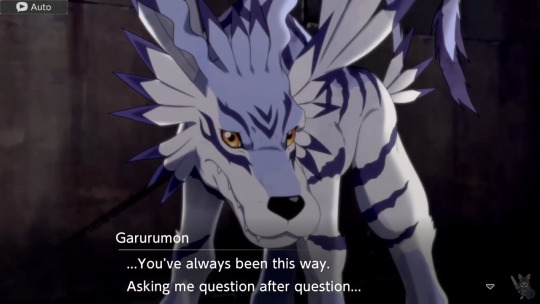
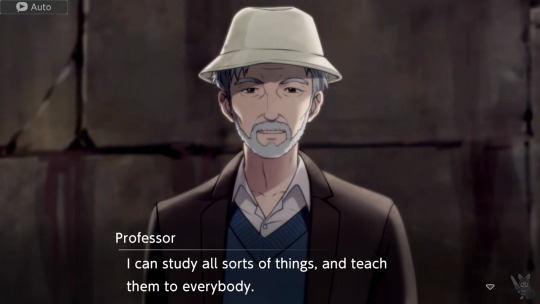
Every Digimon series needs a designated infodump character to unpack what’s going on with the worldbuilding and all, and back in Adventure Koushirou was the main bearer of this role -- in fact, he was so important that he ended up constantly showing up in 02 despite not technically being a part of the advertised main cast. At first, it seems as if the Professor really is mostly just this, and it’s initially even questionable how helpful of one he’ll be when it seems like he’s died at the end of Part 3. But not only does the Professor return to provide more info behind what’s going on, he also ends up becoming instrumental to determining the difference between the endings, because whether he’s present or not and how much he’s learned become the biggest influencing factors on the outcome. (The Harmony route involves the gate being opened much less aggressively than in the Wrathful route, but it’s implied things still had a worse outcome than they did in the Truthful route because the Professor wasn’t able to be there anymore to give any guidance, and the Moral route has everyone seal off the gate because him never uncovering the truth behind the Master meant they destroyed it and thus the system that gave the boundary between worlds any stability.)
The Truthful route happens thanks to the chain reaction of Ryo saving Shuuji and Shuuji becoming the Professor’s assistant, allowing him to more effectively dig up the truth regarding the Four Holy Beasts, the Master, and Haruchika -- hence why it’s called the “truthful” route, not simply in terms of being a “true ending”, but also in terms of it being the ending where the truth behind it all was revealed. Through flashbacks and eventually some outright statements, we learn that as even as a kid, Akiharu actually had quite a bit in common with Koushirou, in terms of being timid and deferential yet bursting with intellectual curiosity and a desire to know more. Back in Adventure, Koushirou managed to uncover some very important things about the Digital World thanks to the fact he actively pursued anything he was interested in, and while Akiharu spending his life studying the Kemonogami might initially seem to be his way of coping with the traumatic loss of his sister and memories, he tells Garurumon in the Truthful route that it was simply his encounter with him that inspired him to learn more and teach others.
The ending of the Truthful route draws parallels between the siblings Haruchika and Yukiha with their descendants Haru and Miyuki, but their situations are reversed; Haruchika was the one “abandoned” by his sister, whereas Miyuki was “abandoned” back in the Digital World when she sent her brother back, and thus the Master attempts to claim Miyuki as someone who should sympathize with him only to find that she bears absolutely none of the malice he does. And like Yukiha, Akiharu doesn’t give up on finding his sibling again and eventually manages to do so, despite going through trauma and memory loss (and some scorn from the scientific community) to get there. On the flip side, Garurumon ends up bearing the emotional pain of being left behind, but in the Moral and Truthful routes he can’t bring himself to hold the grudge for too long once it becomes clear Akiharu really didn’t mean for that to happen. In the end, despite all the trouble that happened between Akiharu, Miyuki, Garurumon, and Renamon, none of them were able to hold onto their grudges, and that’s what eventually allows them to save Haruchika from his own.
Haruchika

You might be wondering, wait, what, this guy? Well, you see, in the Truthful route we find out that he was a sacrifice for others to have power, and he decided to take out his feelings of betrayal out on the world and bring it down with him. Now how does that correlate to anything in Adventure --
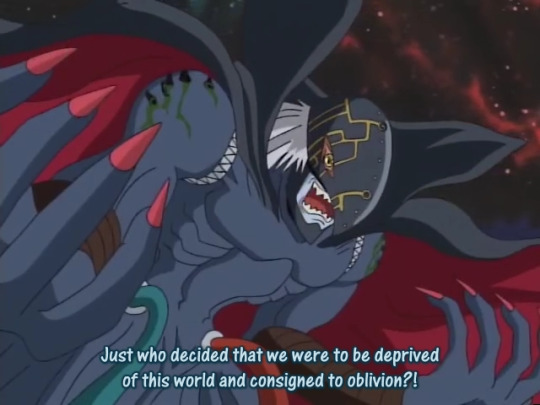
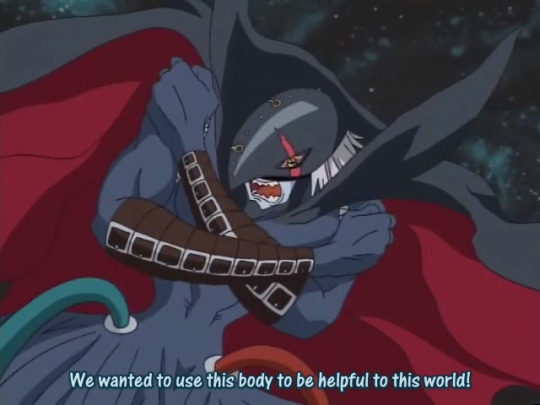
-- oh, okay.
I’m sure a lot of Adventure fans who finished the Truthful route were probably at least able to figure out the parallel overall, but inspecting it closely reveals there’s even more than you might think -- Haruchika is deliberately drawn as a parallel to Akiharu in a sort of Survive equivalent to a “fallen Chosen Child”, and his laments rather parallel Apocalymon’s “we wanted to live and speak of friendship, justice, and love!” And in the Moral route version of things, the Master forces the kids to go through trials of overcoming their darkest feelings and reaffirming how far they’ve come, quite similar to the reaffirmations in Adventure episode 53.
Fortunately for Haruchika, his much deeper contextual relation to Survive’s story and themes (and therefore sympathetic qualities) allow him to be saved and to pass on properly with Yukiha, which certainly beats going out in a failed suicide bombing. Adventure, as a sort of pioneer for Digimon works thereafter, had Apocalymon serve as the “inhibitor of evolution” compared to Adventure’s “story of evolution”, but Survive, which spends more time examining what a Digimon partner even is in the first place, thus has Haruchika represent more of a challenge to what the Survive kids learn to find and what ultimately saves Haruchika himself in the end: as the theme song says, turning hatred into love. Haruchika himself is said to be the first to have realized that bonds between humans and Digimon made each other stronger -- basically being the inventor of Digimon partnerships in this universe -- only for him to end up succmbing to his own hatred and the malice of the world.
Also, when you really think about it, the Master is the closest thing you can say to entities that “chose” the kids as the Survive equivalent of Chosen Children -- at least, in the sense that their distortions dragged the kids into the Digimon world in order to prey on them. Homeostasis and the Agents were still guilty of dragging Adventure’s Chosen Children into the Digital World and not really giving them good explanations, but Homeostasis rather courteously explains in Adventure episode 45 that they were doing it out of desperation for lack of many other options. However, Homeostasis also made it clear that they didn’t have many abilities on their own besides housekeeping, and that the kids would have to be the one to figure the rest out on their own (the novels clarify that it’s really nothing more than a security system), whereas the Master does pose himself in a deity-like position and even has the entire stability of the Digital World depend on him -- it’s just that they’re also quite the opposite of cooperative. So in both cases, regardless of the initial circumstances, the groups involved had to solve the problem on their own will.
203 notes
·
View notes
Photo



Digimon Adventure (1999) Episode 54 | A New World
#Digimon#Digimon Adventure#digigifs#digimonedit#da1999#Bree rewatches adventure#Breegifs#and with that#the rewatch is over#so sad
443 notes
·
View notes
Text
Discotek Media Announces Anime Releases for December 2022
Discotek Media Announces Anime Releases for December 2022
Discotek Media has announced that it will release Digimon Adventure, Saiyuki Reload: Burial, Project A-ko 3, and Lupin the 3rd: Farewell to Nostradamus on Blu-ray, and Machine Robo Battle Hackers on Standard Definition Blu-ray on December 27, 2022. Digimon Adventure will include an English dub, English closed captions, and all 54 episodes in 1080p high definition on Region A discs. Machine Robo…

View On WordPress
13 notes
·
View notes
Photo










Digimon Adventure (Blind Watch) - Episode 54
This episode was tailor made to be a tearjerker. It didn’t work on me, but it was still really sweet. Peak moments for me were Koushiro hugging Tentomon (my favorite duo <3) and Mimi finally getting to say goodbye to Palmon on the train. Acoustic version of the OP helped heighten the emotion too. It felt a little forced that Gennai was like “you have to leave immediately because of XYZ that the writers just pulled out of their butts,” but I rather have this kind of ending then one with the kids just continuing to enjoy the digiworld. Gotta have that pathos.
Notes:
-The final battle felt kind of rushed, but when has a fight in this show not felt rushed? It’s not really what I’m here for anyway. I was ready for the meat and potatoes of the episode: the emotional goodbye.
-There was still some awkward animation shortcuts used in this episode which is disappointing for the grand finale. They did make up for it though with the variety of shots/settings in the goodbye scenes and the great visual of the digieggs raining from the sky as the digiworld heals. With a bit more polish things would have been just right.
-Gennai’s aside about not all virus digimon being bad kinda reminded me of Harry Potter and Slytherin. I wonder if any of the future teams contain virus types?
-Now that I’ve reached episode 54 I can say for sure that Sora was a really boring character lol. I feel like she was just super flat and her relationship with Piyomon wasn’t that remarkable either. That was the goodbye I cared about the least.
-I thought Joe and Hikari’s goodbyes were pretty interesting because of the lack of emotion. Hikari and Tailmon didn’t know each other that long and Joe and Gomamon never fully clicked (which Joe remarks on) but are still good buddies. Those two goodbyes were more cordial than sad.
-Already said it but Tentomon and Koushiro’s goodbye was everything. I loved Koushiro being stiff to the end and not knowing how to express his affection. Tentomon reassures him that he doesn’t have to know what to say and then they hug -sniff- so beautiful...
-Mimi lost her iconic hat and Hikari gave away her whistle!! I wonder if either will ever be brought up again...
Whelp. That’s the end of that. Not a mind-blowing show by any means, but it was very fun and there was a lot to love. I’ll never have that nostalgic connection to it like others, but I look forward to continuing with the series and seeing how it grows from here. I’m especially looking forward to Tamers which everyone says is the most interesting entry in the franchise. Hopefully I’ll pick up more favorite characters/digis along the way!
12 notes
·
View notes
Text
this is like one of the most divorced men alive i mean hes only been divorced once but just glance at him and you can tell hes divorced. everything he does or says is extremely divorced. of course a divorced guy would find out his son has a creature and not even bat an eye. i have no personal opinions on this guy negative or positive my one singular opinion is that he is divorced which is actually factual. you would know this if you watched digimon (digital monsters just in case you happened to not know)adventure 1999. i did though because i watched it a few times in fact. and what i gathered from all 54 episodes is that this guy is divorced

8 notes
·
View notes
Photo
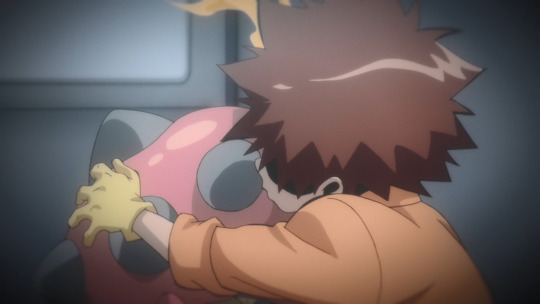

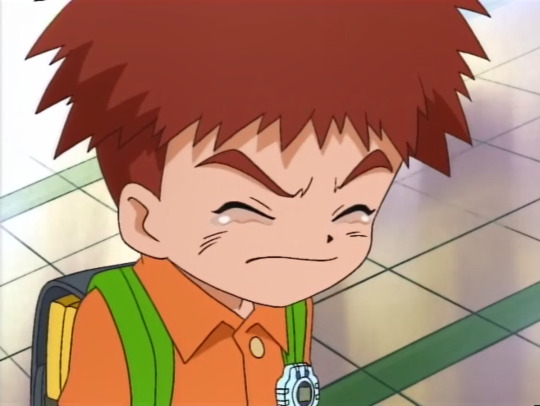
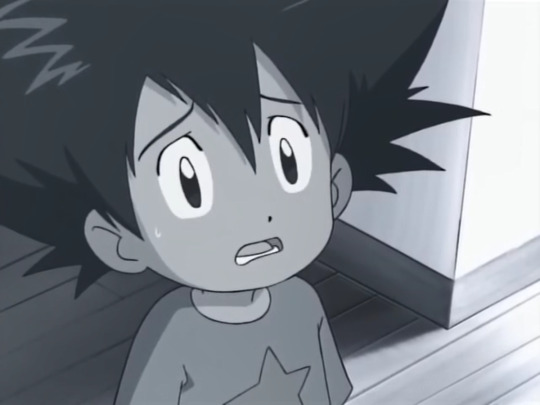
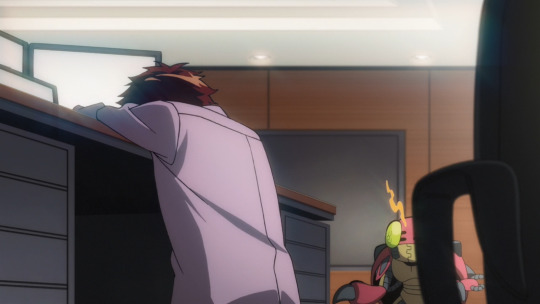
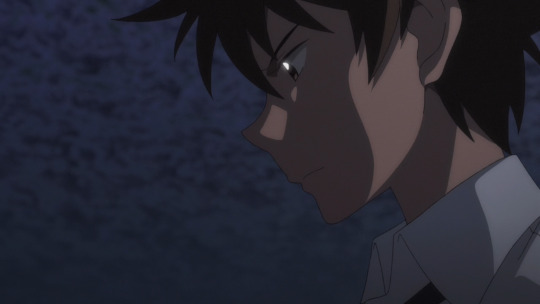




Digimon Adventures ~ - Adventure Episode 21 {Taichi says Goodbye to Hikari} - Adventure Episode 38 {Koushiro’s Adoption Reveal} - Adventure Episode 48 {Taichi’s Secret Reveal} - Adventure Episode 54 {Koushiro says Goodbye to Tentomon} - Tri Movie #3, “Kokuhaku” [“Confession”] {Koushiro’s Meltdown} - Tri Movie #6 “Bokura no Mirai” [“Our Future”] {Taichi cries out in response to the event Taichi JUST WITNESSED} featuring DUO/SHIP/OTP: Taichi Yagami x Koushiro[u] Izumi {KOUTAI}/{Taishiro}
“Is it wrong to want to KNOW Everything?” - Koushiro Izumi, Adventure Episode #24, immediately before ‘entering’ Vademon’s Dimension, {Implied} against Koushiro’s Will
A.K.A just before being dragged down into the “Mysterious Sacred Universe”, and being forced to give up Koushiro’s “Inquisitive Heart” (Note: the U.S. dub referred to it as “Curiosity”, but “Inquisitive Heart” is the actual term used in the original version.)
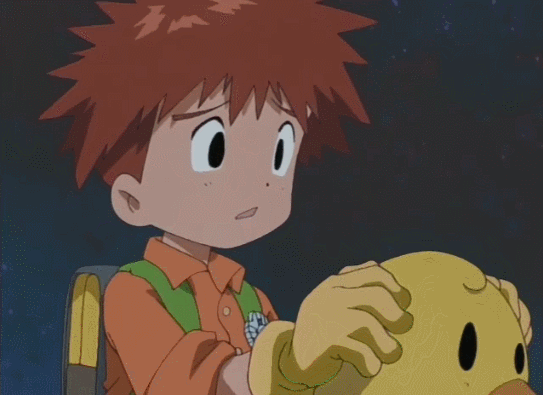
{ It’s OK if you DON’T KNOW Everything }
- Probably, what BOTH Koushiro (AND the person Koushiro cares about) Needs to Hear
caps/gifs by izzyizumi, {DO NOT re-post} {DO NOT remove caption} {Please ASK to Use} {usage of caps/gifs may be allowed if permission is asked / or if credit is given. However, read my about & FAQ pages first. Please do NOT use / ask if you match anything in my “Do Not Interact” sections.}

{Additional note: this post is mainly intended AS SHIP/OTP. please remember + RESPECT this when interacting please tag only as the ship name and DO NOT tag as only “brotp” or the like only*, thank you!} (*It is ok if you tag as “friendship” or the like along with the ship!!)

[Note: commenting/tagging positively/respectfully is ok!] (Please AGREE TO BANNERS BEFORE interacting) (Note: click on the banners to enlarge!)
#digimon adventure#digimon adventure tri#taishiro#koushiro izumi#taichi yagami#koushirou izumi#yagami taichi#taichi x koushiro#izzyizumi posts#izzyizumi edits#izzyizumi caps#izzyizumi taichi caps#izzyizumi koushiro caps#izzyizumi taishiro photosets#adv taichi#otp: shall we go together#is it wrong to want to know everything#(and this is basically a major part of the entire theme of both the ficverse AND the AMVs I've been doing)#(Very tired of seeing people in this fan base mischaracterize these two so they can either dehumanize or demonize either)#stop dehumanizing koushiro izumi 2k22#stop dehumanizing taichi yagami 2k22#stop demonizing koushiro izumi 2k22#stop demonizing taichi yagami 2k22#koushiro izumi is a good character#taichi yagami is a good character#taichi support event#(I actually made this right at the start of me starting Taichi positivity focus for my blog like well over a year ago by now)#(And I'll still see people in this fan base making awful comments about Taichi to this day)#(I'm just... really tired??? Leave Taichi and his fans alone?? Leave Koushiro and his fans alone?? Yeah??? Y e S OK Anyhow)#(Again I spend a lot of time compiling these so I'd appreciate respectful Interaction if you choose to Interact or re blog this post Please)
3 notes
·
View notes
Text
Looking at Discotek’s announcement for their release of the original Digimon Adventure reminds me how fucked up it is that all four arcs of the original Digimon series- Devimon, Etemon and Datamon, Myotismon, and the Dark Masters- all happened over just 54 episodes.
It’s a combination of how time is perceived differently when you’re younger and how new episodes only came out weekly, but I genuinely thought that series ran for 200 episodes.
4 notes
·
View notes
Photo










Digimon Adventure: 2020 – Episode 54: The Vagrant War Demon, Rebellimon (Review)
Thoughts on the fifty-fourth episode of the Digimon Adventure reboot series.
Well, this was certainly a pleasant surprise. A good episode! Those are very rare in this series. uwu
The narration had to tell us that Taichi and Agumon parted ways with Jou’s group, instead of the episode referencing it at all . . . lol.
Because this episode just dropped us right into the middle of the action! And it actually worked. \o/ The action itself was very nice, too.
I loved the Giromons’ voices when they were saying “Rebellimon”, lol.
Oooh, very nice quick flashback shot of Ogremon when MetalGreymon and Rebellimon clashed! OGREMON LIVES! I definitely like him a lot more in the reboot than I did in the OG. So that’s a rare plus for the reboot! (I still don’t care for his counterpart Leomon at all though, in either continuity, lol.)
Taichi: “Looks like Rebellimon has issues.” NGL this made me laugh, hahaha.
Cutemon definitely lives up to her name! What a cutie pie. :)
Cutemon informs us of Rebellimon’s backstory and it’s a super simple one about him appearing one day without any memory of his past, but that he must “win” and so challenges other Digimon to battles. He happened to “save” Cutemon by chance when other Digimon were bullying her and now she cares about him - but Rebellimon is a tsundere to her. They’re like tri. Yamato and Mimi in Digimon form, lmao. XD;
Every time Greymon gets into a fight that seems “hard”, I always think, why not just evolve into WarGreymon and be done with it in two seconds? This is what happens in the endgame when you create a powerful beast way before the final arc - and then give us filler Digimon to fight against. :P
I really liked seeing Boltmon in the anime! I only know him from Digimon Links, lol.
So Rebellimon saves Cutemon from Boltmon, a Digimon who had previously defeated him in battle. Rebellimon to Cutemon: “Answer me. Why did you . . . Why did I save you? Why did my body move?” Awwww. I dig this a lot.
Cutemon heals Rebellimon and he manages to defeat Boltmon. Yay! :P The animation this episode was better than usual . . . and I’m wondering why, lol. Should you not save your budget for plot-relevant episodes, Toei?
OMG little mouse Digimon!? I hate mice, but they were cute. XD;
Rebellimon lets Cutemon go with him and this partnership is sooo cute. uwu Props to Toei for letting us care about a Digimon bond/relationship in one episode. Now if only they did that for their main cast and their partner Digimon . . .
Cutemon: “What about you, Taichi and Agumon?” Taichi: “We’re going that way. What about you two?” Rebellimon: “Straight ahead . . .” Taichi & Agumon: “What?” Taichi: “You hear that?” Agumon: “Yeah, I heard it. But . . .” Taichi & Agumon: “No way!” lmao. These two, I swear. And then we get a shot of Rebellimon’s horn! :D I really like that the Ogremon reveal wasn’t overt, actually. Sometimes less is more. :)
This was definitely a filler episode . . . but a quality filler episode. I really liked the tone. So I shall accept it! uwu
But I’m not sure why Toei is giving a side character quality writing (for a kids’ show) instead of its actual main characters . . . Sora, Jou and Hikari in particular are forever crying. ;_; Taichi, too. But at least he was in this quality episode . . . even though he did next to nothing.
Next episode: MIMI! ROSEMON! Will we get another quality episode!? I hope so! :)
#digimon#digimon adventure#digimon adventure:#digimon adventure 2020#taichi yagami#review#screenshots#spoilers#quality filler exists? yes!
16 notes
·
View notes
Text
Digimon Adventure Reboot, Episode 54
reaction/thoughts.
- After Taichi left Jou’s group, for ………..some reason, look we aren’t going to even pretend anymore.
- Fun fact about the chainsaw wielding devil-balls, they are vaccine type, a type commonly attributed with the “good guys”
- Mysterious stranger, Rebellimon. And he doesn’t even seem to have a cause.
- Cutemon is suicidal
- This dinosaur fighting a green demihuman feels familiar, but slightly more mechanical than normal
- Rebellimon is like Primape, if it’s adrenaline stops flowing it’s heart will stop pumping and it will die
- Luckily in the Digital world, getting your ass handed to you doesn’t mean death unless you are Leomon
- Once again, Taichi is about to learn a harsh lesson about the risks of fighting alongside…oh never mind
- So when Agumon gets hurt he doesn’t need to wait 3+ episodes and a hot spring to recover
- Man if only there was something Taichi and Agumon could do against a Mega, like some form of spirit bomb knock off.
- You know, Boltmon is a zombie type, so crazy as it sounds, Cutemon might be able to heal him to death.
- “Why did I protect you? Answer me!”
- This series is pretty Shonen, so Rebellimon is going to out Shonen Boltmon to win. Level be damned.
- Oh yeah, the twist is Rebellimon is Ogremon. (also hinted at with “who failed to die.”)
- So this was a pretty actiony epsidoe, with a basic character arc for someone we will….hopefully see again? Had some good animation if you are just here for the fights
- Next time….We learn our Babmon lore?
#Digimon#Digimon adventure 2020#digimon adventure reboot#digi spoilers#psi spoilers#digimon adventure psi#digimon adventure
9 notes
·
View notes